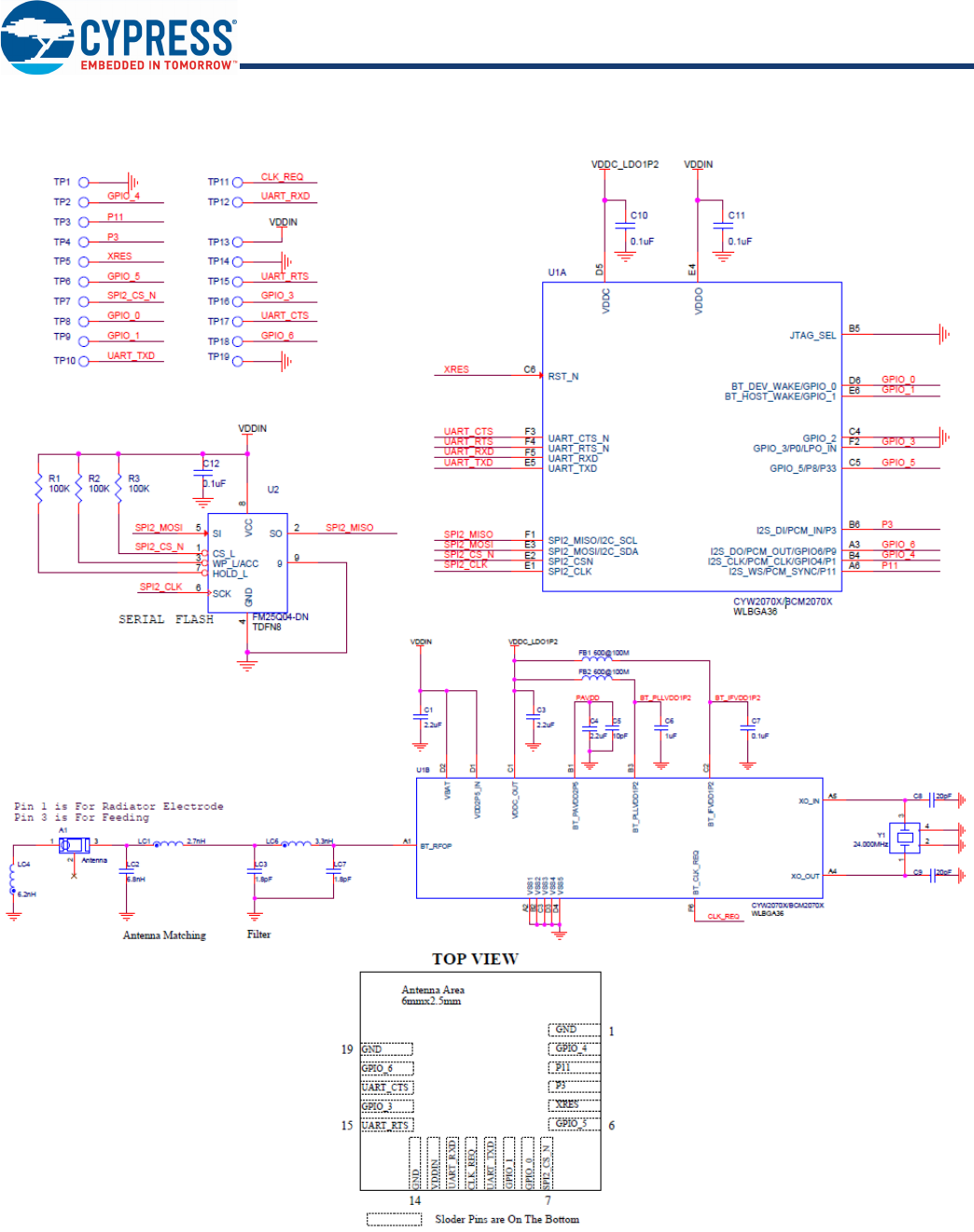Cypress Semiconductor 3027 This product is a Bluetooth wireless EZ-BT WICED Module User Manual CYBT 013033 01 EZ BT Module
Cypress Semiconductor This product is a Bluetooth wireless EZ-BT WICED Module CYBT 013033 01 EZ BT Module
User Manual - 0502

PRELIMINARY CYBT-353027-02
EZ-BT™ WICED Module
Cypress Semiconductor Corporation • 198 Champion Court • San Jose,CA 95134-1709 • 408-943-2600
Document Number: 002-23132 Rev. ** Revised March 14, 2018
General Description
The CYBT-353027-02 is a fully integrated Bluetooth Smart
Ready wireless module. The CYBT-353027-02 includes an
onboard crystal oscillator, passive components, flash memory,
and the Cypress CYW2070x silicon device.
The CYBT-353027-02 supports peripheral functions (ADC,
timers), UART, I2C, and SPI communication, and a Bluetooth
audio interface. The CYBT-353027-02 includes a royalty-free
BLE stack compatible with Bluetooth 5.0 in a 9.0 × 9.0 × 1.75 mm
SMT package.
The CYBT-353027-02 includes 512 KB of onboard serial flash
memory and is designed for standalone operation. The
CYBT-353027-02 uses an integrated power amplifier to achieve
Class I or Class II output power capability.
The CYBT-353027-02 is fully qualified by Bluetooth SIG and is
targeted at space constrained applications.
Module Description
nModule size: 9.00 mm × 9.00 mm × 1.75 mm
nBluetooth 5.0 Qualified Smart Ready module
pQDID: TBD
pDeclaration ID: TBD
nCertified to FCC, ISED, MIC, and CE regulations
nCastelated solder pad connections for ease-of-use
n512-KB on-module serial flash memory
nUp to 8 GPIOs
nTemperature range: -30 °C to +85 °C
nCortex-M3 32-bit processor
nMaximum TX output power:
p+12 dbm for Bluetooth Classic
p+9 dBm for Bluetooth Low Energy
nRX Receive Sensitivity:
p–93.5 dBm for Bluetooth Classic
p–96.5 dBm for Bluetooth Low Energy
Power Consumption[1]
nTX average current consumption: 52.5 mA (EDR) at 8 dBm
nRX average current consumption: 26.4 mA (EDR)
nLow power mode support
pDeep Sleep: 2.69 uA
Functional Capabilities
nΣ-Δ ADC for audio (12 bits) and DC measurement (10 bits)
nSerial Communications interface compatible with I2C slaves
nMaster Serial Peripheral Interface (SPI) support
nHCI interface through UART
nPCM/I2S Audio interface
nTwo-wire Global Coexistence Interface (GCI)
nProgrammable output power control
nSupports extended synchronous connections (eSCO), for
enhanced voice quality by allowing for retransmission of
dropped packets
nBluetooth wideband speech support
Benefits
CYBT-353027-02 provides all necessary components required
to operate BLE and/or BR/EDR communication standards.
nProven hardware design ready to use
nDual-mode operation eliminates the need for multiple modules
nCost optimized for applications without space constraints
nNonvolatile memory for self-sufficient operation and
Over-the-air updates
nBluetooth SIG Listed with QDID and Declaration ID
nFully certified module eliminates the time needed for design,
development and certification processes
nWICED™ STUDIO provides an easy-to-use integrated design
environment (IDE) to configure, develop, and program a
Bluetooth application
Note
1. The values in this section were calculated for a 90% efficient DC-DC at 3V in HCI mode, and based on a Class I configuration bench-marked at Class II. Lower values
are expected for a class II configuration using an external LPO and corresponding PA configuration.

Document Number: 002-23132 Rev. ** Page 2 of 50
PRELIMINARY CYBT-353027-02
More Information
Cypress provides a wealth of data at www.cypress.com to help you to select the right module for your design, and to help you to
quickly and effectively integrate the module into your design.
References
nOverview: EZ-BLE/BT Module Portfolio, Module Roadmap
nDevelopment Kits:
pCYBT-353027-EVAL, CYBT-353027-02 Evaluation Board
nTest and Debug Tools:
pCYSmart, Bluetooth® LE Test and Debug Tool (Windows)
pCYSmart Mobile, Bluetooth® LE Test and Debug Tool
(Android/iOS Mobile App)
nKnowledge Base Article
pKBA97095 - EZ-BLE™ Module Placement
pKBA213976 - FAQ for BLE and Regulatory Certifications with
EZ-BLE modules
pKBA210802 - Queries on BLE Qualification and Declaration
Processes
pKBA218122 - 3D Model Fils for EZ-BLE/EZ-BT Modules
Development Environments
Wireless Connectivity for Embedded Devices (WICED) Studio Software Development Kit (SDK)
Cypress' WICED® (Wireless Connectivity for Embedded Devices) is a full-featured platform with proven Software Development Kits
(SDKs) and turnkey hardware solutions from partners to readily enable Wi-Fi and Bluetooth® connectivity in system design.
WICED Studio is the only SDK for the Internet of Things (ioT) that combines Wi-Fi and Bluetooth into a single integrated development
environment. In addition to providing WICED APIs and an application framework designed to abstract complexity, WICED Studio also
leverages many common industry standards.
Technical Support
nCypress Community: Whether you’re a customer, partner or a developer interested in the latest Cypress innovations, the Cypress
Developer Community offers you a place to learn, share and engage with both Cypress experts and other embedded engineers
around the world.
nFrequently Asked Questions (FAQs): Learn more about our Bluetooth ECO System.
nVisit our support page and create a technical support case or contact a local sales representatives. If you are in the United States,
you can talk to our technical support team by calling our toll-free number: +1-800-541-4736. Select option 2 at the prompt.

Document Number: 002-23132 Rev. ** Page 3 of 50
PRELIMINARY CYBT-353027-02
Contents
Overview............................................................................ 4
Functional Block Diagram ........................................... 4
Module Description...................................................... 4
Pad Connection Interface ................................................ 6
Recommended Host PCB Layout ................................... 7
Module Connections ........................................................ 9
Connections and Optional External Components....... 10
Power Connections (VDDIN)..................................... 10
External Reset (XRES).............................................. 10
Multiple-Bonded GPIO Connections ......................... 11
Critical Components List ........................................... 13
Antenna Design......................................................... 13
Bluetooth Baseband Core ............................................. 14
Link Control Layer ..................................................... 14
Frequency Hopping Generator.................................. 15
Power Management Unit................................................ 15
RF Power Management ............................................ 15
Host Controller Power Management ......................... 15
BBC Power Management.......................................... 15
Microcontroller Unit ....................................................... 16
NVRAM Configuration Data and Storage.................. 16
External Reset (XRES).............................................. 16
Integrated Radio Transceiver ........................................ 18
Transmitter Path........................................................ 18
Receiver Path............................................................ 18
Local Oscillator Generation....................................... 18
Calibration ................................................................. 18
Internal LDO .............................................................. 18
Collaborative Coexistence............................................. 19
Global Coexistence Interface ........................................ 19
SECI I/O .................................................................... 19
Peripheral and Communication Interfaces .................. 20
Cypress Serial Communications Interface ................ 20
HCI UART Interface .................................................. 20
Peripheral UART Interface ........................................ 21
Serial Peripheral Interface......................................... 21
.PCM Interface .......................................................... 22
Clock Frequencies..................................................... 22
ADC Port ................................................................... 22
GPIO Port.................................................................. 23
Electrical Characteristics............................................... 24
Chipset RF Specifications ............................................. 26
Timing and AC Characteristics ..................................... 29
UART Timing............................................................. 29
SPI Timing................................................................. 30
BSC Interface Timing ................................................ 32
PCM Interface Timing................................................ 33
I2S Interface Timing .................................................. 37
Environmental Specifications ....................................... 39
Environmental Compliance ....................................... 39
RF Certification.......................................................... 39
Safety Certification .................................................... 39
Environmental Conditions ......................................... 39
ESD and EMI Protection ........................................... 39
Regulatory Information .................................................. 40
FCC........................................................................... 40
ISED.......................................................................... 41
European Declaration of Conformity ......................... 42
MIC Japan................................................................. 42
Packaging........................................................................ 43
Ordering Information...................................................... 45
Acronyms........................................................................ 46
Document Conventions ................................................. 48
Units of Measure ....................................................... 48
Document History Page................................................. 49
Sales, Solutions, and Legal Information ...................... 50
Worldwide Sales and Design Support....................... 50
Products .................................................................... 50
PSoC® Solutions ...................................................... 50
Cypress Developer Community................................. 50
Technical Support ..................................................... 50
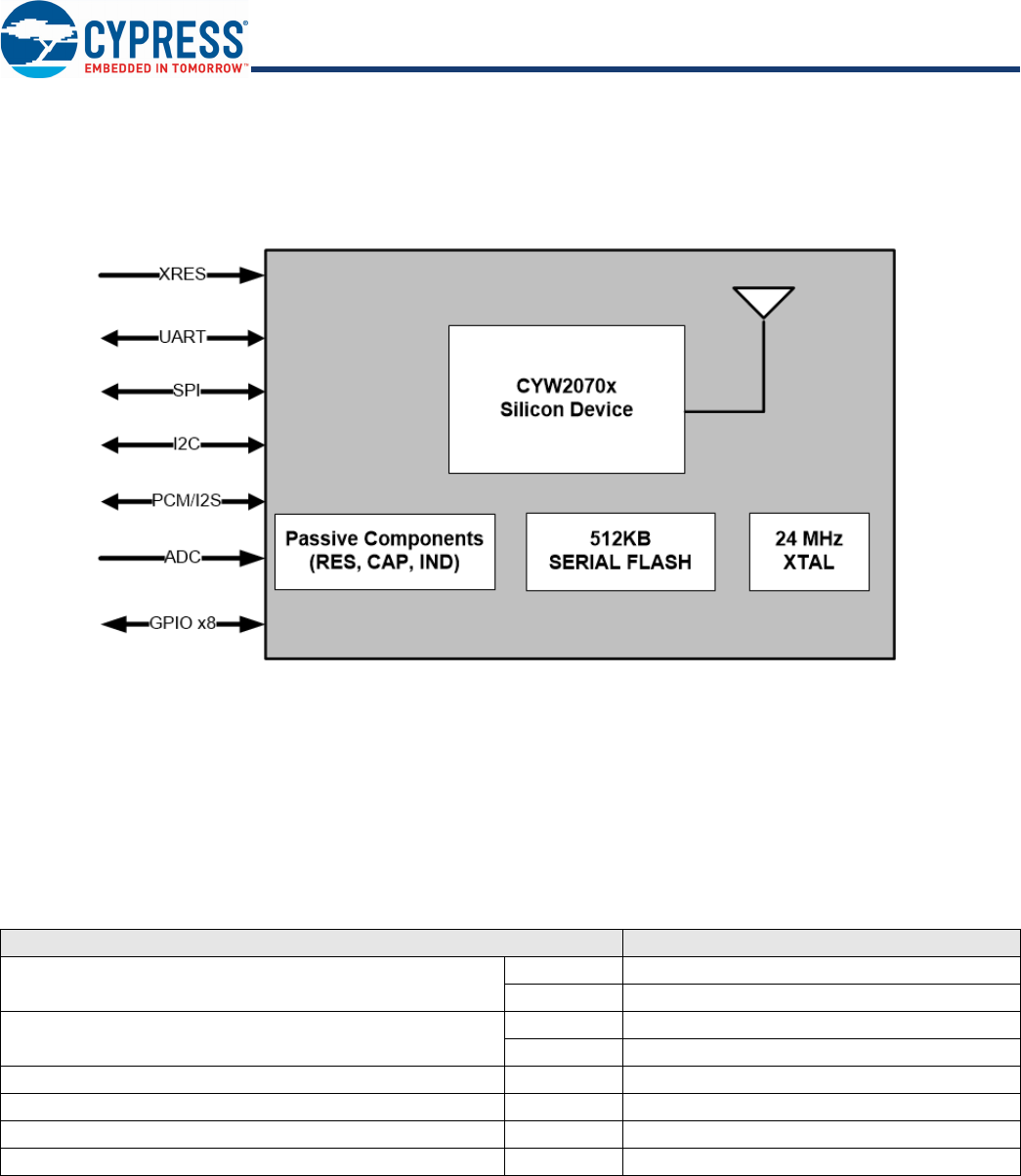
Document Number: 002-23132 Rev. ** Page 4 of 50
PRELIMINARY CYBT-353027-02
Overview
Functional Block Diagram
Figure 1 illustrates the CYBT-353027-02 functional block diagram.
Figure 1. Functional Block Diagram
Module Description
The CYBT-353027-02 module is a complete module designed to be soldered to the application’s main board.
Module Dimensions and Drawing
Cypress reserves the right to select components from various vendors to achieve the Bluetooth module functionality. Such selections
will still guarantee that all mechanical specifications and module certifications are maintained. Designs should be held within the
physical dimensions shown in the mechanical drawings in Figure 2 on page 5. All dimensions are in millimeters (mm).
Table 1. Module Design Dimensions
See Figure 2 for the mechanical reference drawing for CYBT-353027-02.
Dimension Item Specification
Module dimensions Length (X) 9.00 ± 0.15 mm
Width (Y) 9.00 ± 0.15 mm
Antenna area dimensions Length (X) 6.00 mm
Width (Y) 2.50 mm
PCB thickness Height (H) 0.50 ± 0.10 mm
Shield height Height (H) 1.25 mm typical
Maximum component height Height (H) 1.25 mm typical
Total module thickness (bottom of module to highest component) Height (H) 1.75 mm typical
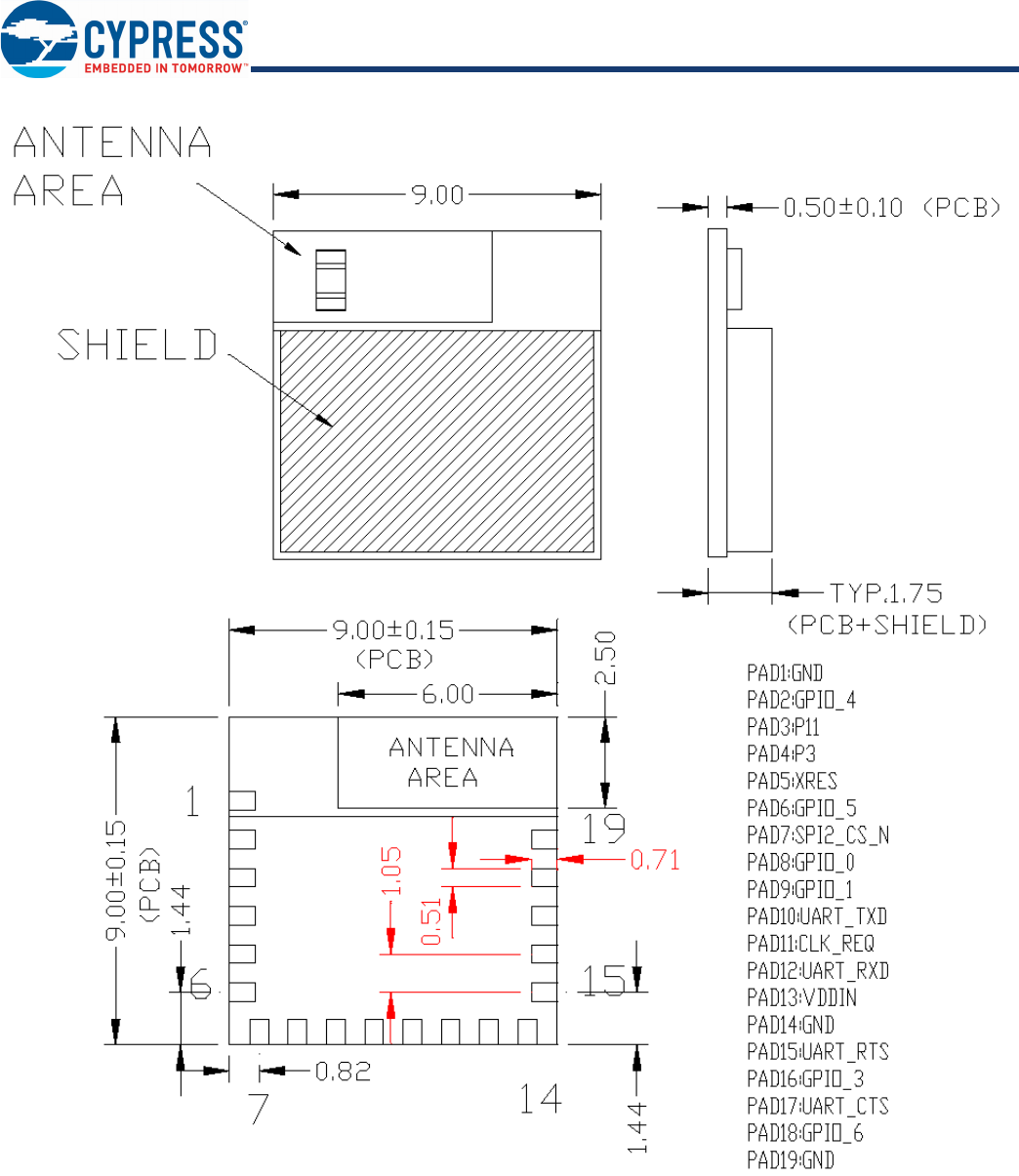
Document Number: 002-23132 Rev. ** Page 5 of 50
PRELIMINARY CYBT-353027-02
Figure 2. Module Mechanical Drawing
Bottom View (Seen from Bottom)
Top View (Seen from Top)
Side View
Notes
2. No metal should be located beneath or above the antenna area. Only bare PCB material should be located beneath the antenna area. For more information on
recommended host PCB layout, see “Recommended Host PCB Layout” on page 7.
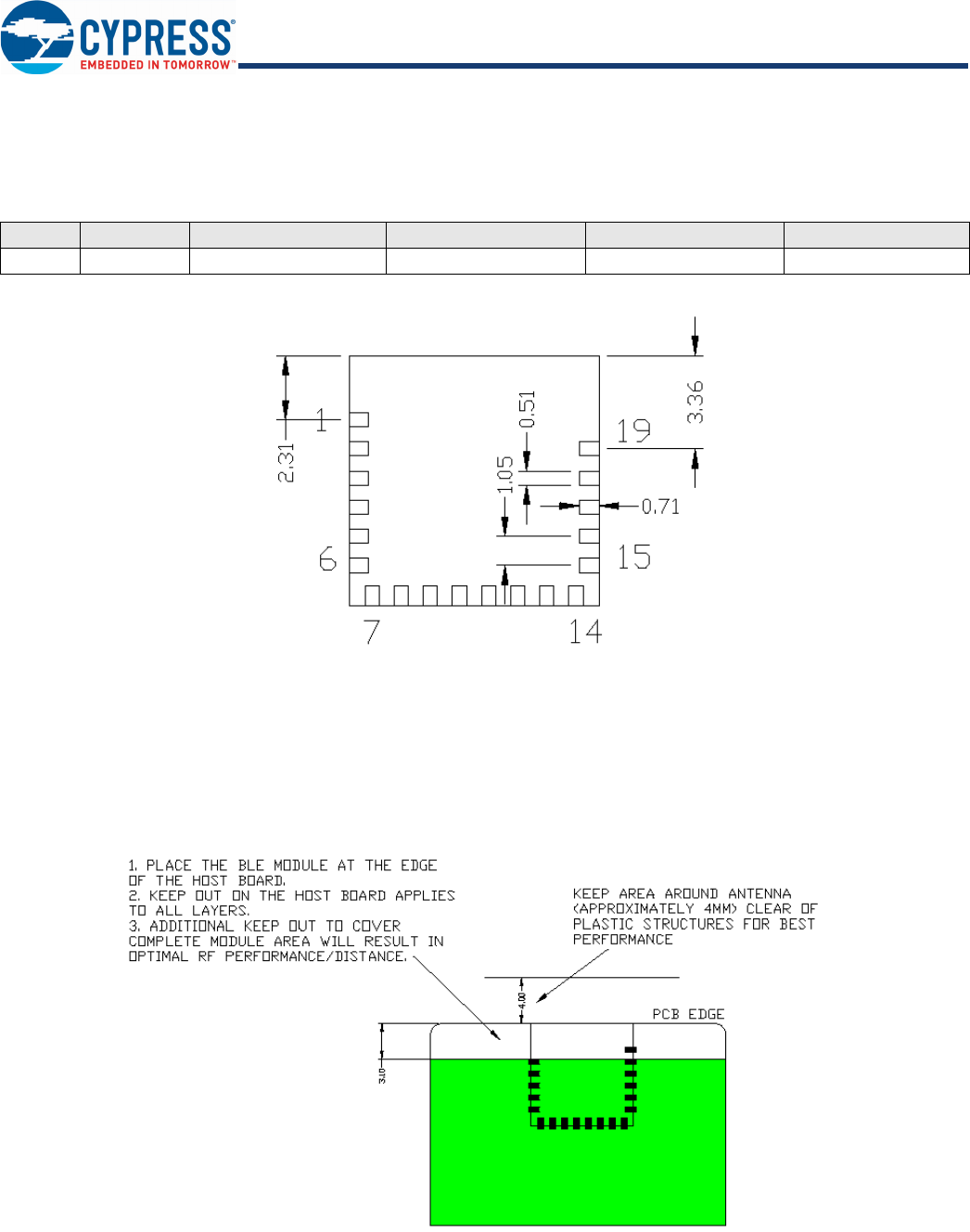
Document Number: 002-23132 Rev. ** Page 6 of 50
PRELIMINARY CYBT-353027-02
Pad Connection Interface
As shown in the bottom view of Figure 2 on page 5, the CYBT-353027-02 connects to the host board via solder pads on the backside
of the module. Table 2 and Figure 3 detail the solder pad length, width, and pitch dimensions of the CYBT-353027-02 module.
Figure 3. Solder Pad Dimensions (Seen from Bottom
To maximize RF performance, the host layout should follow these recommendations:
1. Antenna Area Keepout: The host board directly below the antenna area of the Cypress module (see Figure 2 on page 5) must
contain no ground or signal traces. This keep out area requirement applies to all layers of the host board.
2. Module Placement: The ideal placement of the Cypress Bluetooth module is in a corner of the host board with the PCB trace
antenna located at the far corner. This placement minimizes the additional recommended keep out area stated in item 2. Refer to
AN96841 for module placement best practices.
Figure 4. Recommended Host PCB Keep Out Area Around the CYBT-353027-02 Antenna
Table 2. Connection Description
Name Connections Connection Type Pad Length Dimension Pad Width Dimension Pad Pitch
SP 24 Solder Pads 0.71 mm 0.51 mm 1.05 mm
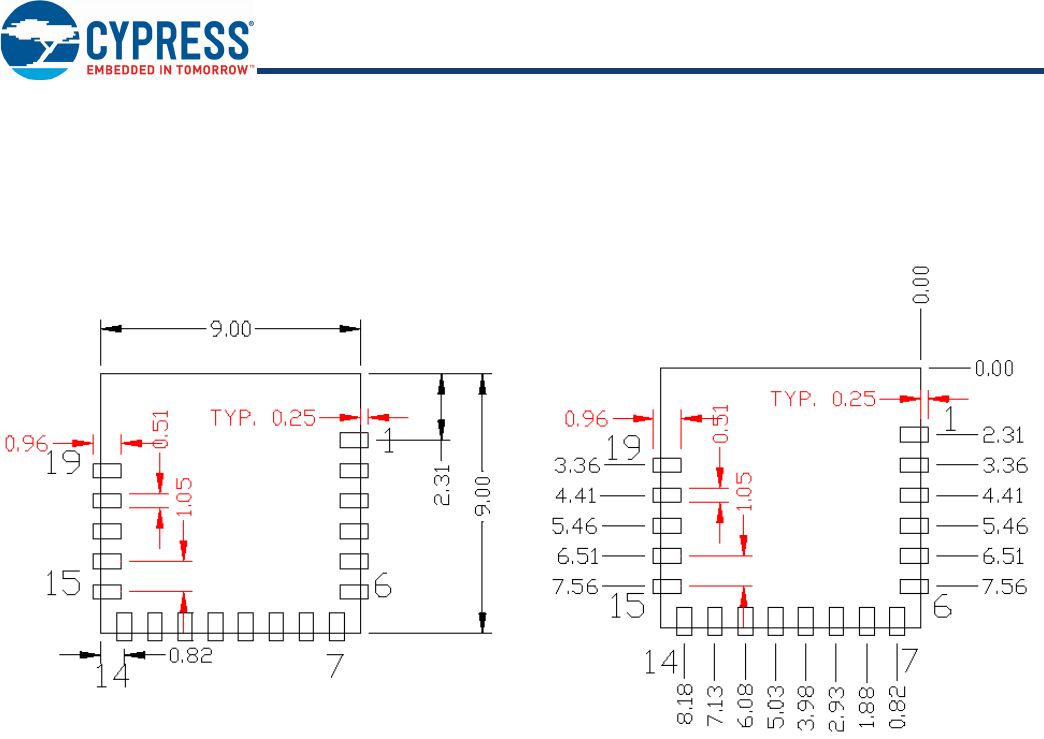
Document Number: 002-23132 Rev. ** Page 7 of 50
PRELIMINARY CYBT-353027-02
Recommended Host PCB Layout
Figure 5, Figure 6, Figure 7, and Table 3 provide details that can be used for the recommended host PCB layout pattern for the
CYBT-353027-02. Dimensions are in millimeters unless otherwise noted. Pad length of 0.96 mm (0.48 mm from center of the pad on
either side) shown in Figure 7 is the minimum recommended host pad length. The host PCB layout pattern can be completed using
either Figure 5, Figure 6, or Figure 7. It is not necessary to use all figures to complete the host PCB layout pattern.
Figure 5. CYBT-353027-02 Host Layout (Dimensioned) Figure 6. CYBT-353027-02 Host Layout (Relative to Origin)
Top View (Seen on Host PCB)
Top View (Seen on Host PCB)
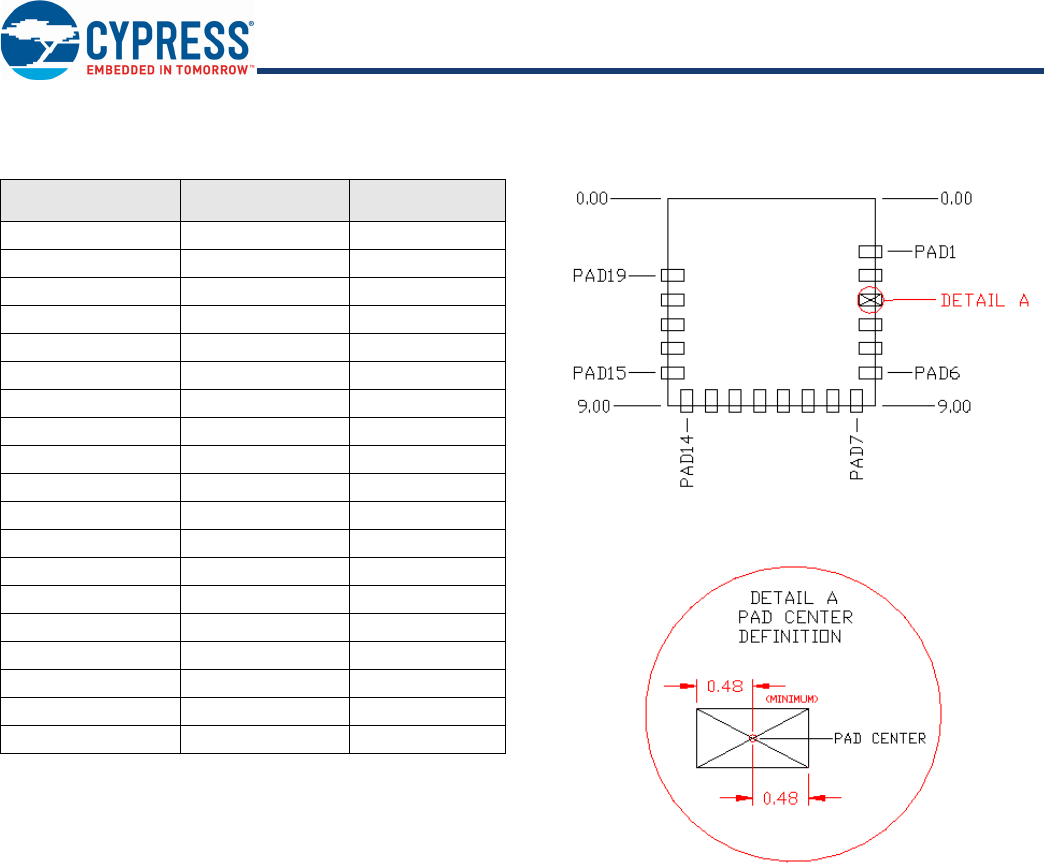
Document Number: 002-23132 Rev. ** Page 8 of 50
PRELIMINARY CYBT-353027-02
Tab le 3 provides the center location for each solder pad on the CYBT-353027-02. All dimensions are referenced to the center of the
solder pad. Refer to Figure 7 for the location of each module solder pad.
Table 3. Module Solder Pad Location Figure 7. Solder Pad Reference Location
Solder Pad
(Center of Pad)
Location (X,Y) from
Orign (mm)
Dimension from
Orign (mils)
1 (0.23, 2.31) (9.06, 119.29)
2 (0.23, 3.36) (9.06, 132.28)
3 (0.23, 4.41) (9.06, 201.97)
4 (0.23, 5.46) (9.06, 243.31)
5 (0.23, 6.51) (9.06, 284.65)
6 (0.23, 7.56) (9.06, 297.64)
7 (0.82,8.77) (32.28, 345.27)
8 (1.88,8.77) (74.02, 345.27)
9 (2.93,8.77) (115.35, 345.27)
10 (3.98,8.77) (156.69, 345.27)
11 (5.03,8.77) (198.03, 345.27)
12 (6.08,8.77) (239.37, 345.27)
13 (7.13,8.77) (280.71, 345.27)
14 (8.18,8.77) (322.05, 345.27)
15 (8.77,7.56) (345.27, 297.64)
16 (8.77,6.51) (345.27,256.30)
17 (8.77,5.46) (345.27, 214.96)
18 (8.77,4.41) (345.27, 173.62)
19 (8.77,3.36) (345.27, 132.28)
Top View (Seen on Host PCB)
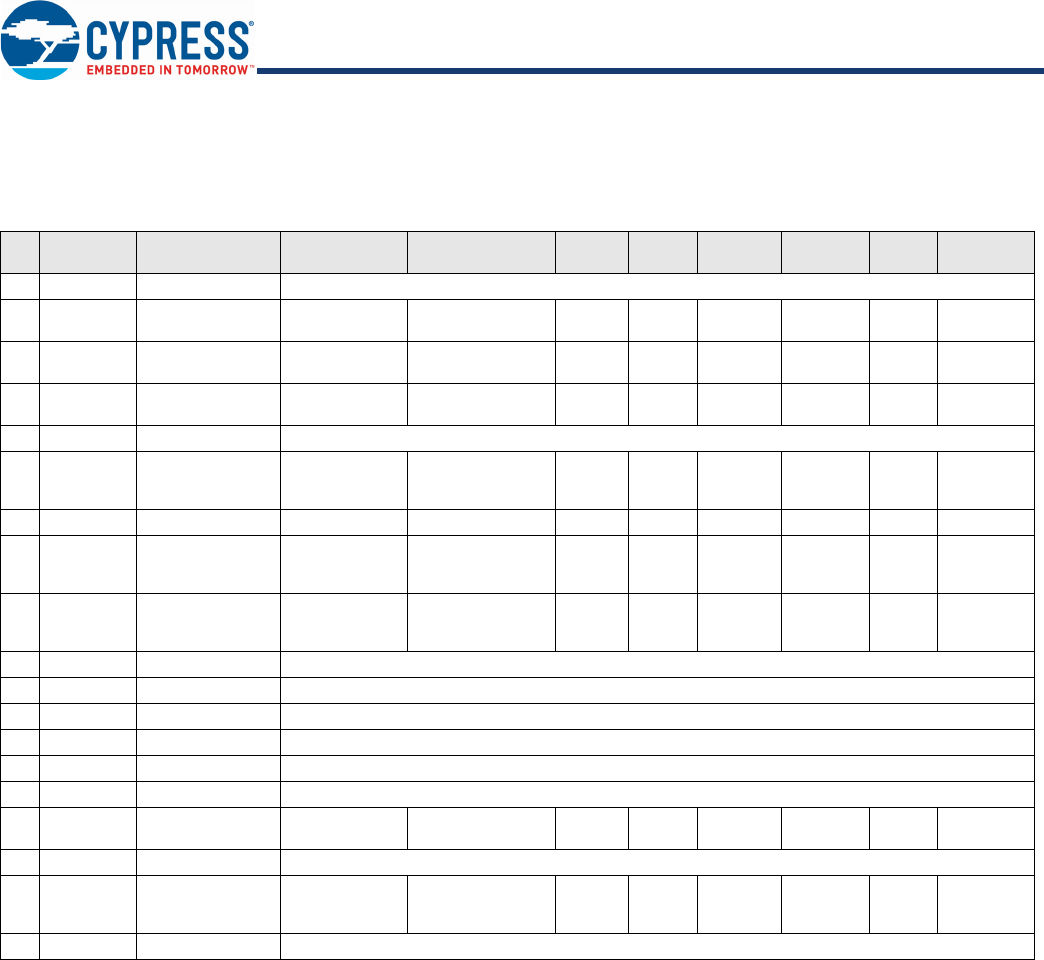
Document Number: 002-23132 Rev. ** Page 9 of 50
PRELIMINARY CYBT-353027-02
Module Connections
Tab le 4 details the solder pad connection definitions and available functions for the pad connections for the CYBT-353027-02 module.
Tab le 4 lists the solder pads on the CYBT-353027-02 module, the silicon device pin, and denotes what functions are available for each
solder pad.
Table 4. CYBT-353027-02 Solder Pad Connection Definitions
Pad Pad Name Silicon Port Pin
Name(s) UART SPI[3] I2C ADC COEX CLK/XTAL GPIO Other
1 GND GND Ground
2GPIO_4
GPIO_4/P1/I2S_C
LK/PCM_CLK SPI1_MISO/P1
(master) IN28/P1 3PCM_CLK
I2S_CLK
3P11
P11/I2S_WS/PCM
_SYNC IN24 3PCM_Sync
I2S_WS
4P3
P3/I2S_DI/PCM_I
NSPI1_CLK
(master) SDA 3PCM_DI
I2S_DI
5 XRES RST_N External Reset (Active Low)
6GPIO_5
BT_GPIO_5/P8/P3
3PUART_RX/P33 IN27/P8
IN6/P33
3
(GCI_SEC
I_OUT) ACK1/P33 3
7 SPI2_CS_N SPI2_CSN[4] SPI2_CS_N
8GPIO_0 BT_GPIO_0
3
(Dev
Wake)
9GPIO_1 BT_GPIO_1
3
(Host
Wake)
10 UART_TXD BT_UART_TXD HCI UART Transmit Data
11 CLK_REQ BT_CLK_REQ Used for shared-clock applications
12 UART_RXD BT_UART_RXD HCI UART Receive Data
13 VDDIN VDDO VDDIN (2.3V ~ 3.6V)
14 GND GND Ground
15 UART_RTS BT_UART_RTS_N HCI UART Request To Send Output
16 GPIO_3 BT_GPIO_3/P0 PUART_TX/P0 SPI1_MOSI/P0
(master) IN29/P0 3
17 UART_CTS BT_UART_CTS_N HCI UART Clear To Send Input
18 GPIO_6 BT_GPIO_6/P9/I2
S_DO/PCM_OUT SCL IN26/P9
3
(GCI_SEC
I_IN)
3
I2S_DO
PCM_Out
19 GND GND Ground
Note
3. The CYBT-353027-02 contains a single SPI (SPI1) peripheral supporting master configuration. SPI2 is used for on-module serial memory interface.
4. SPI2_CS_N is internally routed on the module to on-board serical flash memory. SPI2_CS_N is made available on module pad 7 to be used for Recover Mode
operation only.
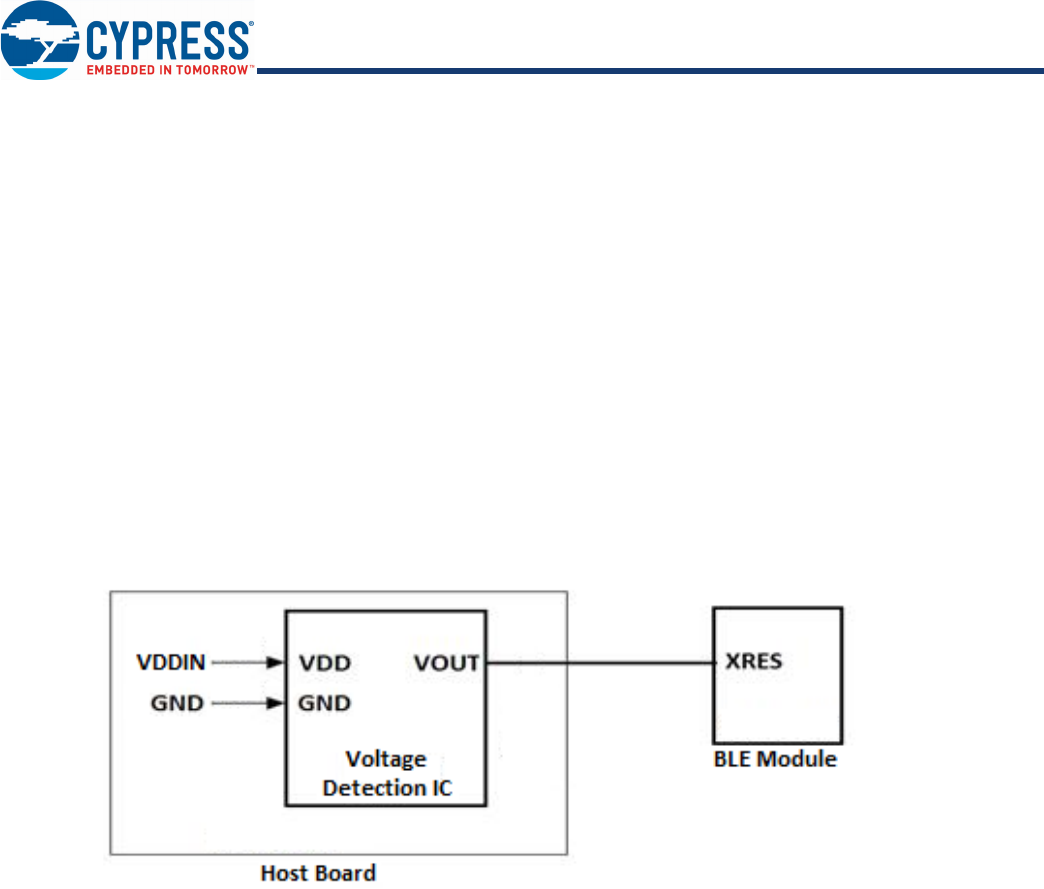
Document Number: 002-23132 Rev. ** Page 10 of 50
PRELIMINARY CYBT-353027-02
Connections and Optional External Components
Power Connections (VDDIN)
The CYBT-353027-02 contains one power supply connection, VDDIN. VDDIN accepts a supply input range of 2.3 V to 3.6 V for
CYBT-353027-02. Table 11 provides this specification. The maximum power supply ripple for this power connection is 100 mV, as
shown in Table 11.
It is not required to place any power supply decoupling or noise reduction circuitry on the host PCB. If desired, an external ferrite bead
between the supply and the module connection can be included, but is not necessary. If used, the ferrite bead should be positioned
as close as possible to the module pin connection and the recommended ferrite bead value is 330 Ω, 100 MHz.
Considerations and Optional Components for Brown Out (BO) Conditions
Power supply design must be completed to ensure that the CYBT-353027-02 module does not encounter a Brown Out condition,
which can lead to unexpected functionality, or module lock up. A Brown Out condition may be met if power supply provided to the
module during power up or reset is in the following range:
VIL ≤ VDDIN ≤ VIH
Refer to Table 12 for the VIL and VIH specifications.
System design should ensure that the condition above is not encountered when power is removed from the system. In the event that
this cannot be guaranteed (that is, battery installation, high-value power capacitors with slow discharge), it is recommended that an
external voltage detection device be used to prevent the Brown Out voltage range from occurring during power removal. Refer to
Figure 8 for the recommended circuit design when using an external voltage detection IC.
Figure 8. Reference Circuit Block Diagram for External Voltage Detection IC
In the event that the module does encounter a Brown Out condition, and is operating erratically or not responsive, power cycling the
module will correct this issue and once reset, the module should operate correctly. Brown Out conditions can potentially cause issues
that cannot be corrected, but in general, a power-on-reset operation will correct a Brown Out condition.
External Reset (XRES)
The CYBT-353027-02 has an integrated power-on reset circuit, which completely resets all circuits to a known power-on state. This
action can also be evoked by an external reset signal, forcing it into a power-on reset state. The XRES signal is an active-low signal,
which is an input to the CYBT-353027-02 module (solder pad 5). The CYBT-353027-02 module does not require an external pull-up
resistor on the XRES input
During power-on operation, the XRES connection to the CYBT-353027-02 is required to be held low 50 ms after the VDD power supply
input to the module is stable. This can be accomplished in the following ways:
nThe host device should connect a GPIO to the XRES of the Cypress CYBT-353027-02 module and pull XRES low until VDD is
stable. XRES is recommended to be released 50 ms after VDDIN is stable.
nIf the XRES connection of the CYBT-353027-02 module is not used in the application, a 10-µF capacitor may be connected to the
XRES solder pad of the CYBT-353027-02 in order to delay the XRES release. The capacitor value for this recommended imple-
mentation is approximate, and the exact value may differ depending on the VDDIN power supply ramp time of the system. The
capacitor value should result in an XRES release timing of 50 ms after VDDIN stability.
nThe XRES release timing may be controlled by a external voltage detection IC. XRES should be released 50 ms after VDD is stable.
Refer to Figure 11 on page 17 for XRES operating and timing requirements during power-on events.

Document Number: 002-23132 Rev. ** Page 11 of 50
PRELIMINARY CYBT-353027-02
Multiple-Bonded GPIO Connections
The CYBT-353027-02 contains GPIOs, which are multiple-bonded at the silicon level. If any of these dual-bonded GPIOs are used,
only the functionality and features for one of these port pins may be used. The desired port pin should be configured in the WICED
Studio SDK. For details on the port pins that are multiple-bonded, refer to the GPIO Port section of this document.
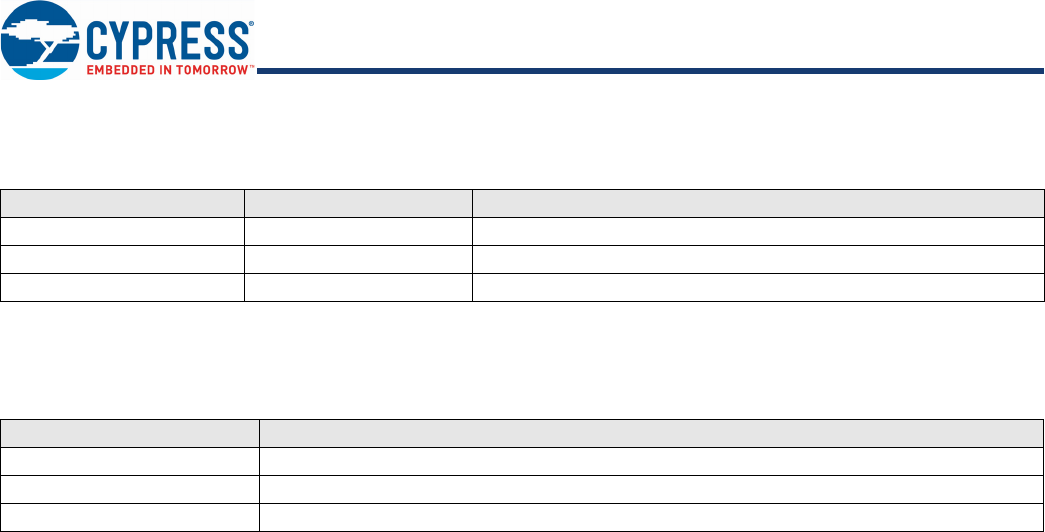
Document Number: 002-23132 Rev. ** Page 13 of 50
PRELIMINARY CYBT-353027-02
Critical Components List
Tab le 5 details the critical components used in the CYBT-353027-02 module.
Table 5. Critical Component List
Antenna Design
Tab le 6 details trace antenna used in the CYBT-353027-02 module. For more information, see Ta ble 6.
Table 6. Chip Antenna Specifications
Component Reference Designator Description
Silicon U1 36-pin FBGA BT/BLE Silicon Device - CYW2070X
Silicon U2 8-pin TDF8N, 512K Serial Flash
Crystal Y1 24.000 MHz, 12PF
Item Description
Frequency Range 2400–2500 MHz
Peak Gain -1.0 dBi typical
Return Loss 10 dB minimum

Document Number: 002-23132 Rev. ** Page 14 of 50
PRELIMINARY CYBT-353027-02
Bluetooth Baseband Core
The Bluetooth Baseband Core (BBC) implements all of the time-critical functions required for high-performance Bluetooth operation.
The BBC manages the buffering, segmentation, and routing of data for all connections. It also buffers data that passes through it,
handles data flow control, schedules SCO/ACL and TX/RX transactions, monitors Bluetooth slot usage, optimally segments and
packages data into baseband packets, manages connection status indicators, and composes and decodes HCI packets. In addition
to these functions, it independently handles HCI event types, and HCI command types. The following transmit and receive functions
are also implemented in the BBC hardware to increase reliability and security of the TX/RX data before sending over the air:
nSymbol timing recovery, data deframing, forward error correction (FEC), header error control (HEC), cyclic redundancy check (CRC),
data decryption, and data dewhitening in the receiver.
nData framing, FEC generation, HEC generation, CRC generation, key generation, data encryption, and data whitening in the
transmitter.
Bluetooth Features
CYBT-353027-02 is qualified to the Bluetooth 5.0 specification. CYBT-353027-02 supports all Bluetooth 4.2 and legacy features, with
the following benefits.
nDual-mode Bluetooth (BT Classic and BLE) operation
nExtended inquiry response (EIR): Shortens the time to retrieve the device name, specific profile, and operating mode.
nEncryption pause resume (EPR): Enables the use of Bluetooth technology in a much more secure environment.
nSniff subrating (SSR): Optimizes power consumption for low duty cycle asymmetric data flow, which subsequently extends battery life.
nSecure simple pairing (SSP): Reduces the number of steps for connecting two devices, with minimal or no user interaction required.
nLink supervision time out (LSTO): Additional commands added to HCI and Link Management Protocol (LMP) for improved link
timeout supervision.
nQuality of service (QoS) enhancements: Changes to data traffic control, which results in better link performance. Audio, human
interface device (HID), bulk traffic, SCO, and enhanced SCO (eSCO) are improved with the erroneous data (ED) and packet boundary
flag (PBF) enhancements.
nSecure connections (BR/EDR)
nFast advertising interval
nPiconet clock adjust
nConnectionless broadcast
nLE privacy v1.1
nLow duty cycle directed advertising
nLE dual mode topology
Link Control Layer
The link control layer is part of the Bluetooth link control functions that are implemented in dedicated logic in the link control unit (LCU).
This layer consists of the command controller that takes commands from the software, and other controllers that are activated or
configured by the command controller, to perform the link control tasks. Each task is performed in a different state in the LCU.
nStates:
pStandby
pConnection
pPage
pPage Scan
pInquiry
pInquiry Scan
pSniff
pAdvertising
pScanning

Document Number: 002-23132 Rev. ** Page 15 of 50
PRELIMINARY CYBT-353027-02
Frequency Hopping Generator
The frequency hopping sequence generator selects the correct hopping channel number based on the link controller state, Bluetooth
clock, and device address.
Power Management Unit
The Power Management Unit (PMU) provides power management features that can be invoked by software through power
management registers or packet-handling in the baseband core.
RF Power Management
The BBC generates power-down control signals for the transmit path, receive path, PLL, and power amplifier to the 2.4-GHz trans-
ceiver, which then processes the power-down functions accordingly.
Host Controller Power Management
Power is automatically managed by the firmware based on input device activity. As a power-saving task, the firmware controls the
disabling of the on-chip regulator when in deep sleep (HIDOFF) mode.
BBC Power Management
There are several low-power operations for the BBC:
nPhysical layer packet handling turns RF on and off dynamically within packet TX and RX.
nBluetooth-specified low-power connection mode. While in these low-power connection modes, the CYBT-353027-02 runs on the
Low Power Oscillator and wakes up after a predefined time period.
The CYBT-353027-02 automatically adjusts its power dissipation based on user activity. The following power modes are supported:
nActive mode
nIdle mode
nSleep mode
nHIDOFF (Deep Sleep) mode
The CYBT-353027-02 transitions to the next lower state after a programmable period of user inactivity. Busy mode is immediately
entered when user activity resumes.
In HIDOFF (Deep Sleep) mode, the CYBT-353027-02 baseband and core are powered off by disabling power to LDOOUT. The VDDO
domain remains powered up and will turn the remainder of the chip on when it detects user events. This mode minimizes chip power
consumption and is intended for long periods of inactivity.
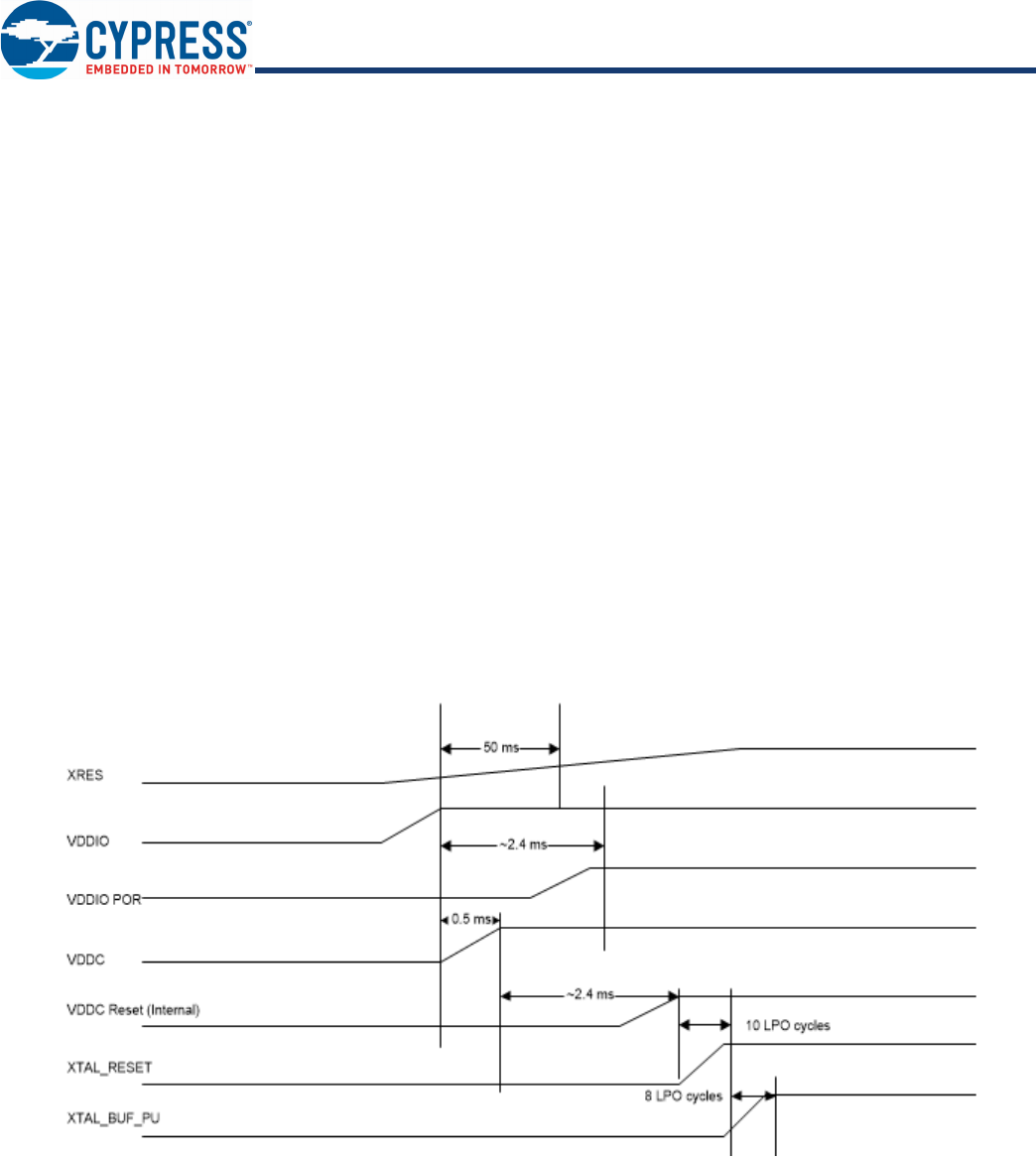
Document Number: 002-23132 Rev. ** Page 16 of 50
PRELIMINARY CYBT-353027-02
Microcontroller Unit
The microcontroller unit in CYBT-353027-02 runs software from the link control (LC) layer up to the host controller interface (HCI).
The microcontroller is based on the Cortex-M3 32-bit RISC processor with embedded ICE-RT debug and JTAG interface units. The
microcontroller also includes 848 KB of ROM memory for program storage and boot ROM, 352 KB of RAM for data scratch-pad, and
patch RAM code.
The internal boot ROM provides flexibility during power-on reset to enable the same device to be used in various configurations. At
power-up, the lower layer protocol stack is executed from the internal ROM.
External patches can be applied to the ROM-based firmware to provide flexibility for bug fixes and features additions. These patches
can be downloaded using external NVRAM. The device can also support the integration of user applications and profiles using an
external serial flash memory.
NVRAM Configuration Data and Storage
NVRAM contains configuration information about the customer application, including the following:
nFractional-N information
nBD_ADDR
nUART baud rate
nSDP service record
nFile system information used for code, code patches, or data. The CYBT-353027-02 uses SPI Serial Flash for NVRAM storage.
External Reset (XRES)
The CYBT-353027-02 has an integrated power-on reset circuit that completely resets all circuits to a known power-on state. An
external active low reset signal, XRES, can be used to put the CYBT-353027-02 in the reset state. The XRES pin has an internal
pull-up resistor and, in most applications, it does not require anything to be connected to it.
Figure 10. External Reset Internal Timing
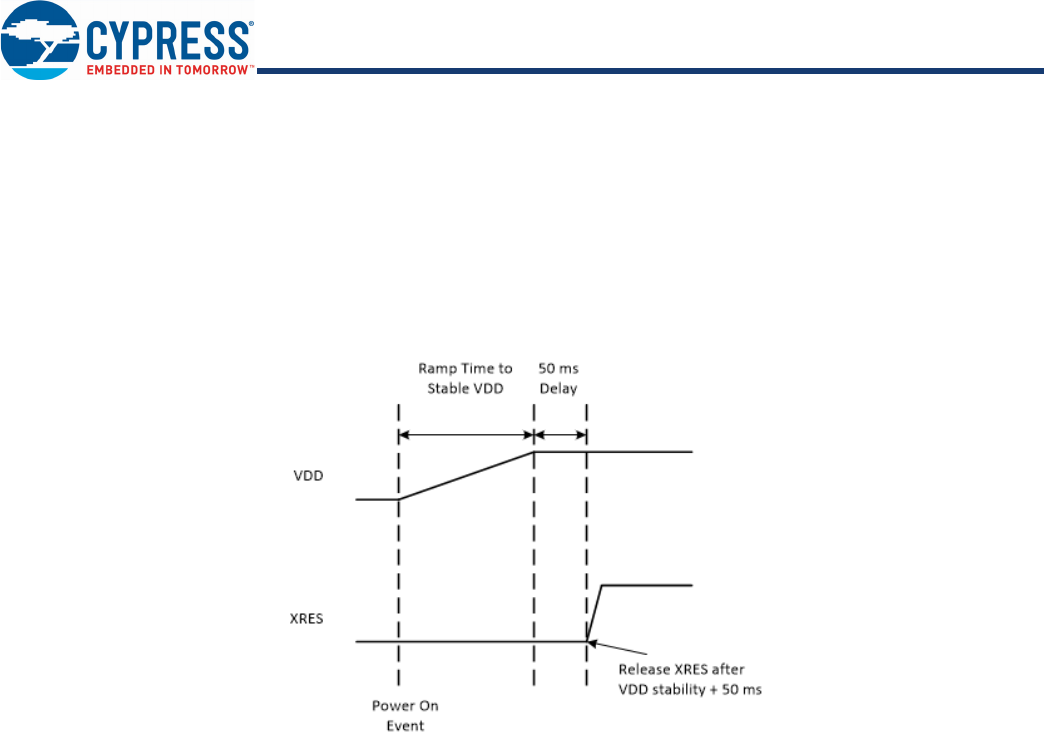
Document Number: 002-23132 Rev. ** Page 17 of 50
PRELIMINARY CYBT-353027-02
External Reset (XRES) Recommended External Components and Proper Operation
During a power-on event, the XRES line of the CYBT-353027-02 is required to be held low 50 ms after the VDD power supply input
to the module is stable. Refer to Figure 11 for the Power-On XRES timing operation. This power-on operation can be accomplished
in the following ways:
nA host device should connect a GPIO to the XRES of the Cypress CYBT-353027-02 module and pull XRES low until VDD is stable.
XRES can be released after VDD is stable.
nIf the XRES connection of the CYBT-353027-02 module is not used in the application, a 10-µF capacitor may be connected to the
XRES solder pad of the CYBT-353027-02.
nThe XRES release timing can also be controlled via an external voltage detection circuit.
Figure 11. Power-On External Reset (XRES) Operation

Document Number: 002-23132 Rev. ** Page 18 of 50
PRELIMINARY CYBT-353027-02
Integrated Radio Transceiver
The CYBT-353027-02 has an integrated radio transceiver that has been optimized for use in 2.4-GHz Bluetooth wireless systems. It
has been designed to provide low-power, low-cost, robust communications for applications operating in the globally available 2.4-GHz
unlicensed ISM band. The CYBT-353027-02 is fully compliant with the Bluetooth Radio Specification and enhanced data rate (EDR)
specification and meets or exceeds the requirements to provide the highest communication link quality of service.
Transmitter Path
The CYBT-353027-02 a fully integrated zero-IF transmitter. The baseband transmit data is GFSK-modulated in the modem block and
upconverted to the 2.4-GHz ISM band in the transmitter path. The transmitter path consists of signal filtering, I/Q upconversion, output
power amplifier, and RF filtering. The transmitter path also incorporates π/4-DQPSK for 2 Mbps and 8-DPSK for 3 Mbps to support
EDR. The transmitter section is compatible with the BLE specification. The transmitter PA bias can also be adjusted to provide
Bluetooth class 1 or class 2 operation.
Digital Modulator
The digital modulator performs the data modulation and filtering required for the GFSK, π4-DQPSK, and 8-DPSK signal. The fully
digital modulator minimizes any frequency drift or anomalies in the modulation characteristics of the transmitted signal and is much
more stable than direct VCO modulation schemes.
Power Amplifier
The fully integrated PA supports Class 1 or Class 2 output using a highly linearized, temperature-compensated design. This provides
greater flexibility in front-end matching and filtering. Due to the linear nature of the PA combined with some integrated filtering, external
filtering is required to meet the Bluetooth and regulatory harmonic and spurious requirements. For integrated mobile handset appli-
cations in which Bluetooth is integrated next to the cellular radio, external filtering can be applied to achieve near thermal noise levels
for spurious and radiated noise emissions. The transmitter features a sophisticated on-chip transmit signal strength indicator (TSSI)
block to keep the absolute output power variation within a tight range across process, voltage, and temperature.
Receiver Path
The receiver path uses a low-IF scheme to downconvert the received signal for demodulation in the digital demodulator and bit
synchronizer. The receiver path provides a high degree of linearity, an extended dynamic range, and high-order on-chip channel
filtering to ensure reliable operation in the noisy 2.4 GHz ISM band. The front-end topology, with built-in out-of-band attenuation,
enables the CYBT-353027-02 to be used in most applications with minimal off-chip filtering. For integrated handset operation, in which
the Bluetooth function is integrated close to the cellular transmitter, external filtering is required to eliminate the desensitization of the
receiver by the cellular transmit signal.
Digital Demodulator and Bit Synchronizer
The digital demodulator and bit synchronizer take the low-IF received signal and perform an optimal frequency tracking and bit
synchronization algorithm.
Receiver Signal Strength Indicator
The radio portion of the CYBT-353027-02 provides a receiver signal strength indicator (RSSI) to the baseband. This enables the
controller to take part in a Bluetooth power-controlled link by providing a metric of its own receiver signal strength to determine whether
the transmitter should increase or decrease its output power.
Local Oscillator Generation
The local oscillator (LO) provides fast frequency hopping (1600 hops/second) across the 79 maximum available channels. The LO
generation sub-block employs an architecture for high immunity to LO pulling during PA operation. The CYBT-353027-02 uses an
internal loop filter.
Calibration
The CYBT-353027-02 radio transceiver features an automated calibration scheme that is fully self-contained in the radio. No user
interaction is required during normal operation or during manufacturing to provide optimal performance. Calibration tunes the perfor-
mance of all the major blocks within the radio to within 2% of optimal conditions, including gain and phase characteristics of filters,
matching between key components, and key gain blocks. This takes into account process variation and temperature variation.
Calibration occurs transparently during normal operation during the settling time of the hops, and calibrates for temperature variations
as the device cools and heats during normal operation in its environment.
Internal LDO
The microcontroller in CYBT-353027-02 uses two LDOs – one for 1.2 V and the other for 2.5 V. The 1.2-V LDO provides power to the
baseband and radio and the 2.5-V LDO powers the PA.

Document Number: 002-23132 Rev. ** Page 19 of 50
PRELIMINARY CYBT-353027-02
Collaborative Coexistence
The CYBT-353027-02 provides extensions and collaborative coexistence to the standard Bluetooth AFH for direct communication
with WLAN devices. Collaborative coexistence enables WLAN and Bluetooth to operate simultaneously in a single device. The device
supports industry-standard coexistence signaling, including 802.15.2, and supports Cypress and third-party WLAN solutions.
Global Coexistence Interface
The CYBT-353027-02 supports the proprietary Cypress Global Coexistence Interface (GCI) which is a 2-wire interface.
The following key features are associated with the interface:
nEnhanced coexistence data can be exchanged over GCI_SECI_IN and GCI_SECI_OUT a two-wire interface, one serial input
(GCI_SECI_IN), and one serial output (GCI_SECI_OUT). The pad configuration registers must be programmed to choose the digital
I/O pins that serve the GCI_SECI_IN and GCI_SECI_OUT function.
nIt supports generic UART communication between WLAN and Bluetooth devices.
nTo conserve power, it is disabled when inactive.
nIt supports automatic resynchronization upon waking from sleep mode.
nIt supports a baud rate of up to 4 Mbps.
SECI I/O
The microcontroller in CYBT-353027-02 has dedicated GCI_SECI_IN (PAD18/GPIO_6) and GCI_SECI_OUT (PAD 6/GPIO_5) pins.
Refer to Table 4, which detail the module solder pad number used for SECI I/O.
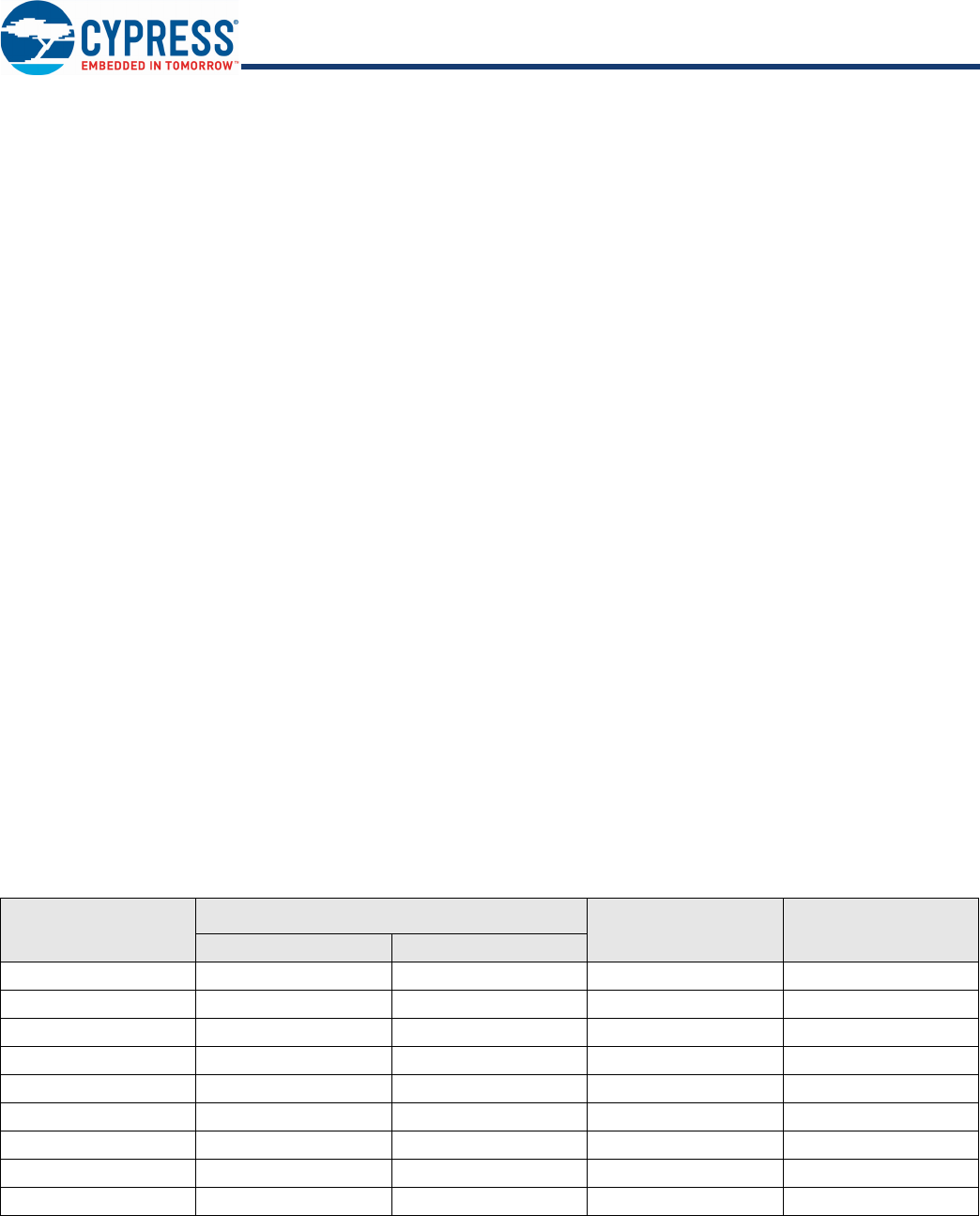
Document Number: 002-23132 Rev. ** Page 20 of 50
PRELIMINARY CYBT-353027-02
Peripheral and Communication Interfaces
Cypress Serial Communications Interface
The CYBT-353027-02 provides a 2-pin master BSC interface, which can be used to retrieve configuration information from an external
EEPROM or to communicate with peripherals such as track-ball or touch-pad modules, and motion tracking ICs used in mouse
devices. The BSC interface is compatible with I2C slave devices. The BSC does not support multimaster capability or flexible wait-state
insertion by either master or slave devices.
The following transfer clock rates are supported by the BSC:
n100 kHz
n400 kHz
n800 kHz (not a standard I2C-compatible speed.)
n1 MHz (Compatibility with high-speed I2C-compatible devices is not guaranteed.)
nThe following transfer types are supported by the BSC:
nRead (Up to 127 bytes can be read)
nWrite (Up to 127 bytes can be written)
nRead-then-Write (Up to 127 bytes can be read and up to 127 bytes can be written)
nWrite-then-Read (Up to127 bytes can be written and up to 127 bytes can be read)
Hardware controls the transfers, requiring minimal firmware setup and supervision.
The clock pad (I2C_SCL) and data pad 2 (I2C_SDA) are both open-drain I/O pins. Pull-up resistors, external to the CYBT-353027-02,
are required on both the SCL and SDA pad for proper operation.
HCI UART Interface
The UART physical interface is a standard, 2-wire interface (RX, TX, RTS, and CTS) with adjustable baud rates from 38400 bps to
6 Mbps. During initial boot, UART speeds may be limited to 750 kbps. The baud rate may be selected via a vendor-specific UART
HCI command. The CYBT-353027-02 has a 1040-byte receive FIFO and a 1040-byte transmit FIFO to support enhanced data rates.
The interface supports the Bluetooth UART HCI (H4) specification. The default baud rate for H4 is 115.2 kbaud.
The UART clock default setting is 24 MHz, and can be configured to run as high as 48 MHz to support up to 6 Mbps. The baud rate
of the CYBT-353027-02UART is controlled by two values. The first is a UART clock divisor (set in the DLBR register) that divides the
UART clock by an integer multiple of 16. The second is a baud rate adjustment (set in the DHBR register) that is used to specify a
number of UART clock cycles to stuff in the first or second half of each bit time. Up to eight UART cycles can be inserted into the first
half of each bit time, and up to eight UART clock cycles can be inserted into the end of each bit time.
Tab le 7 contains example values to generate common baud rates with a 24 MHz UART clock.
Table 7. Common Baud Rate Examples, 24 MHz Clock
Baud Rate (bps) Baud Rate Adjustment Mode Error (%)
High Nibble Low Nibble
3M 0xFF 0xF8 High rate 0.00
2M 0XFF 0XF4 High rate 0.00
1M 0X44 0XFF Normal 0.00
921600 0x05 0x05 Normal 0.16
460800 0x02 0x02 Normal 0.16
230400 0x04 0x04 Normal 0.16
115200 0x00 0x00 Normal 0.16
57600 0x00 0x00 Normal 0.16
38400 0x01 0x00 Normal 0.00
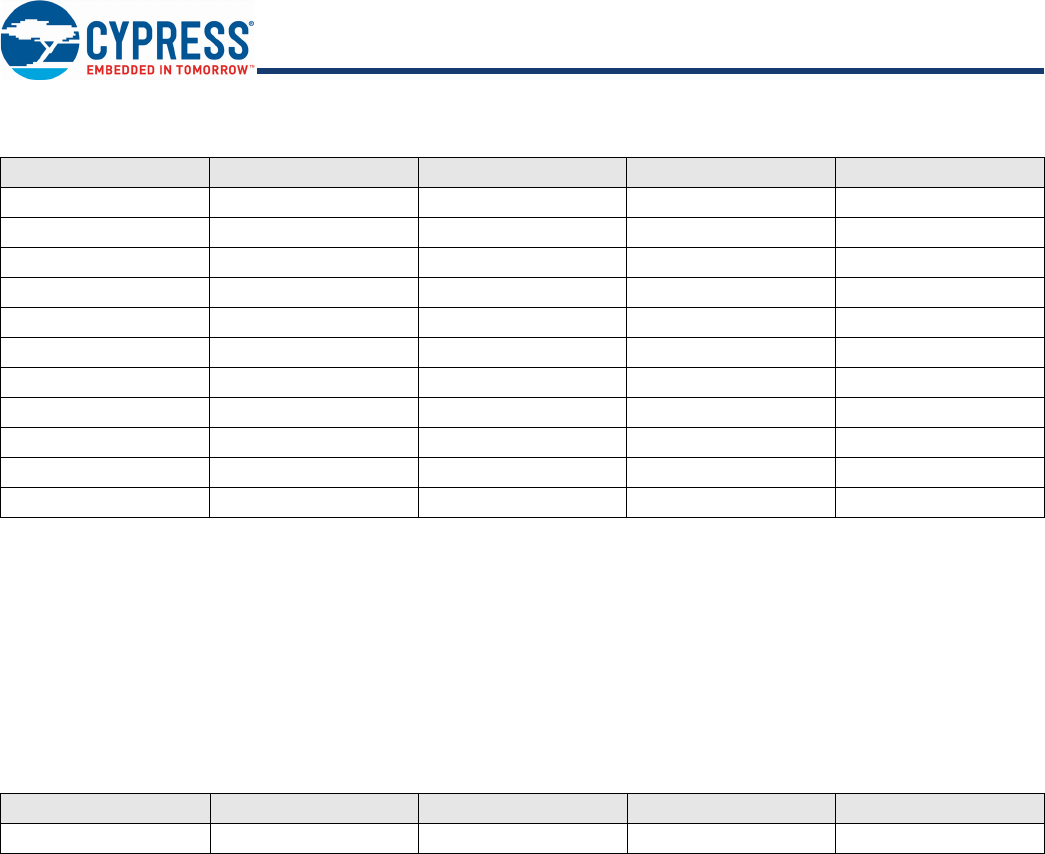
Document Number: 002-23132 Rev. ** Page 21 of 50
PRELIMINARY CYBT-353027-02
Tab le 8 contains example values to generate common baud rates with a 48 MHz UART clock.
Normally, the UART baud rate is set by a configuration record downloaded after reset. Support for changing the baud rate during
normal HCI UART operation is included through a vendor-specific command that allows the host to adjust the contents of the baud
rate registers.
The CYBT-353027-02 UART operates correctly with the host UART as long as the combined baud rate error of the two devices is
within ±2%.
Peripheral UART Interface
The CYBT-353027-02 has a second UART that may be used to interface to other peripherals. This peripheral UART is accessed
through the optional I/O ports, which can be configured individually and separately for each signal as shown in Table 9 The
CYBT-353027-02 supports a two wire UART interface. Flow Control is not supported on this module.
Serial Peripheral Interface
The CYBT-353027-02 has two independent SPI interfaces. One is a master-only interface (SPI2) and is used for on-module SFLASH
interface. The other (SPI1) can be used as a master interface. Each interface has a 64-byte transmit buffer and a 64-byte receive
buffer. To support more flexibility for user applications, the CYBT-353027-02 has optional I/O ports that can be configured individually
and separately for each functional pin. The CYBT-353027-02 acts as an SPI master device that supports 2.3 V or 3.3 V SPI slaves.
The CYBT-353027-02 can also act as an SPI slave device that supports a 2.3 V or 3.3 V SPI master.
SPI voltage depends on VDD; therefore, it defines the type of devices that can be supported
Table 8. Common Baud Rate Examples, 48 MHz Clock
Baud Rate (bps) High Rate Low Rate Mode Error (%)
6M 0xFF 0xF8 High rate 0
4M 0xFF 0xF4 High rate 0
3M 0x0 0xFF Normal 0
2M 0x44 0xFF Normal 0
1.5M 0x0 0xFE Normal 0
1M 0x0 0xFD Normal 0
921600 0x22 0xFD Normal 0.16
230400 0x0 0xF3 Normal 0.16
115200 0x1 0xE6 Normal –0.08
57600 0x1 0xCC Normal 0.04
38400 0x11 0xB2 Normal 0
Table 9. CYBT-353027-02 Peripheral UART
Signal Name PUART_TX PUART_RX PUART_CTS_N PUART_RTS_N
Configured port name P0 P33 - -

Document Number: 002-23132 Rev. ** Page 22 of 50
PRELIMINARY CYBT-353027-02
PCM Interface
The CYBT-353027-02 includes a PCM interface that shares pins with the I2S interface. The PCM Interface on the CYBT-353027-02
can connect to linear PCM codec devices in master or slave mode. In master mode, the CYBT-353027-02 generates the PCM_CLK
and PCM_SYNC signals. In slave mode, these signals are provided by another master on the PCM interface and are inputs to the
CYBT-353027-02.
Slot Mapping
The CYBT-353027-02 supports up to three simultaneous full-duplex SCO or eSCO channels through the PCM interface. These three
channels are time-multiplexed onto the single PCM interface by using a time-slotting scheme where the 8 kHz or 16 kHz audio sample
interval is divided into as many as 16 slots. The number of slots is dependent on the selected interface rate (128 kHz, 512 kHz, or
1024 kHz). The corresponding number of slots for these interface rate is 1, 2, 4, 8, and 16, respectively. Transmit and receive PCM
data from an SCO channel is always mapped to the same slot. The PCM data output driver tristates its output on unused slots to allow
other devices to share the same PCM interface signals. The data output driver tristates its output after the falling edge of the PCM
clock during the last bit of the slot.
Frame Synchronization
The CYBT-353027-02 supports both short- and long-frame synchronization in both master and slave modes. In short-frame synchro-
nization mode, the frame synchronization signal is an active-high pulse at the audio frame rate that is a single-bit period in width and
is synchronized to the rising edge of the bit clock. The PCM slave looks for a high on the falling edge of the bit clock and expects the
first bit of the first slot to start at the next rising edge of the clock. In long-frame synchronization mode, the frame synchronization
signal is again an active-high pulse at the audio frame rate; however, the duration is three bit periods and the pulse starts coincident
with the first bit of the first slot.
Data Formatting
The CYBT-353027-02 may be configured to generate and accept several different data formats. For conventional narrowband speech
mode, the CYBT-353027-02 uses 13 of the 16 bits in each PCM frame. The location and order of these 13 bits can be configured to
support various data formats on the PCM interface. The remaining three bits are ignored on the input and may be filled with 0s, 1s, a
sign bit, or a programmed value on the output. The default format is 13-bit 2’s complement data, left justified, and clocked MSB first.
Burst PCM Mode
In this mode of operation, the PCM bus runs at a significantly higher rate of operation to allow the host to duty cycle its operation and
save current. In this mode of operation, the PCM bus can operate at a rate of up to 24 MHz. This mode of operation is initiated with
an HCI command from the host.
Clock Frequencies
The CYBT-353027-02 has an integrated 24 MHz crystal on the module. There is no need to add an additional crystal oscillator.
ADC Port
The ADC is a Σ-Δ ADC core designed for audio (12 bits) and DC (10 bits) measurement. There are 5 solder pad connections that
can act as input channels on the CYBT-353027-02 module.
The following CYBT-353027-02 module solder pads can be used as ADC inputs:
nPad 2: P1, ADC Input Channel 28
nPad 3: P11, ADC Input Channel 24
nPad 6: P8/P33, ADC Input Channels 27/6 respectively; NOTE: only one ADC input on this solder pad can be active at a given time.
nPad 16: P0, ADC Input Channel 29
nPad 18: P9, ADC Input Channel 26

Document Number: 002-23132 Rev. ** Page 23 of 50
PRELIMINARY CYBT-353027-02
GPIO Port
The CYBT-353027-02 has eight GPIOs besides two I2C pads. All GPIOs support programmable pull-ups and are capable of driving
up to 8 mA at 3.3 V or 4 mA at 1.8 V,.
The following GPIOs are available on the module pads:
nPAD 2 GPIO_4: GPIO_4/P1/I2S_CLK_PCM_CLK (triple bonded; only one of three is available)
nPAD 3 P11: P11/I2S_WS_PCM_SYNC (Dual bonded; only one of two is available)
nPAD 4 P3: P3/I2S_DI_PCM_IN (dual bonded; only one of two is available)
nPAD 6 GPIO_5: GPIO_5/P8/P33 (triple bonded; only one of three is available)
nPAD 8 GPIO_0
nPAD 9 GPIO_1
nPAD 16 GPIO_3: GPIO_3/P0/LPO_IN (triple bonded; only one of three is available)
nPAD 18 GPIO_6: GPIO_6/P9/I2S_DO_PCM_OUT (triple bonded; only one of three is available)
Pads 2, 3, 6, 16, and 18 can be programmed as ADC inputs.
NOTE: SPI2_CS_N is internally routed on the module to on-board serial flash memory. SPI2_CS_N is made available on module pad
7 to be used for Recover Mode operation only. No other functionality should be used with this connection.
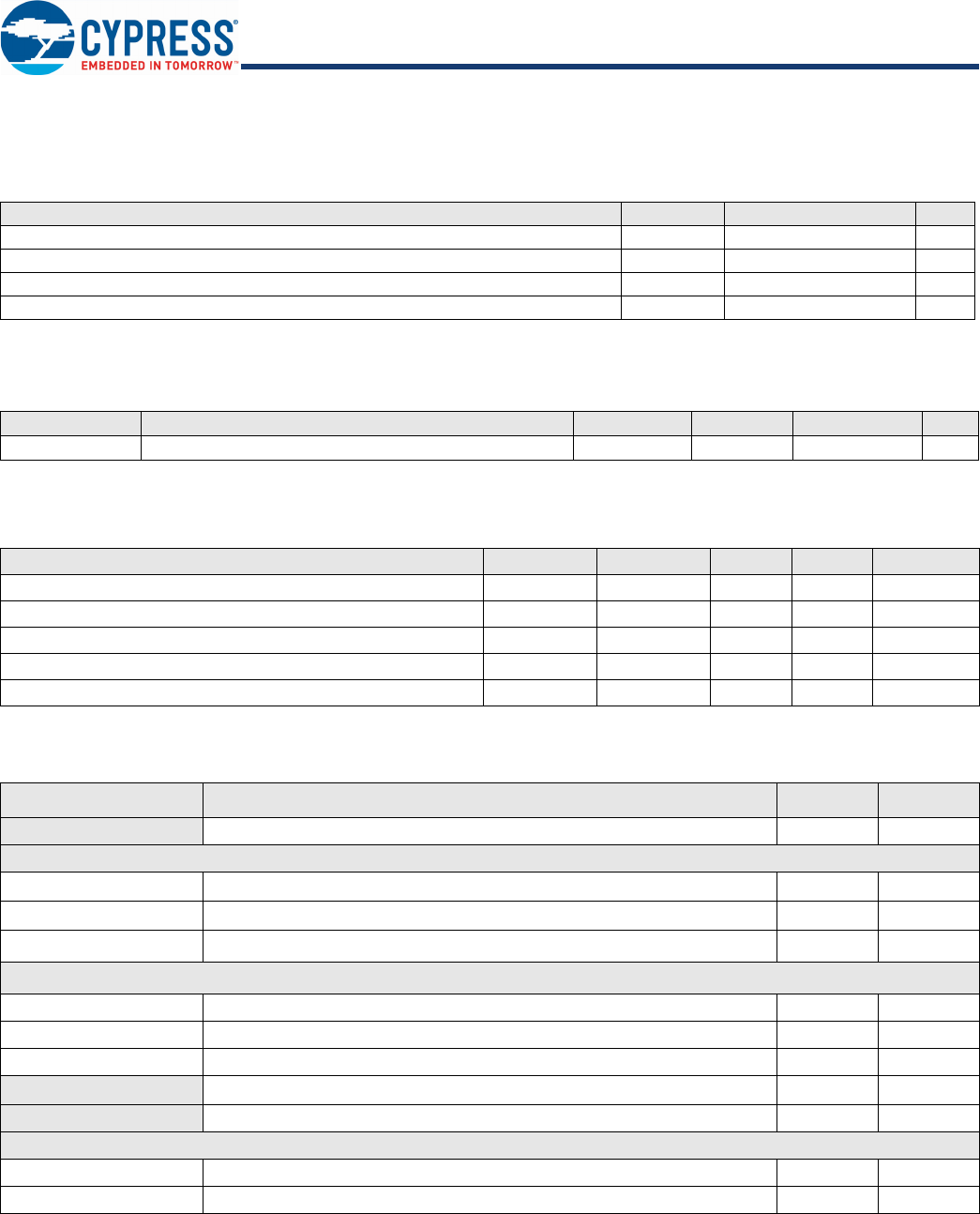
Document Number: 002-23132 Rev. ** Page 24 of 50
PRELIMINARY CYBT-353027-02
Electrical Characteristics
Tab le 10 shows the maximum electrical rating for voltages referenced to VDD pin.
Tab le 11 shows the power supply characteristics for the range TJ = 0 to 125 °C.
Tab le 12 shows the specifications for the digital voltage levels.
Tab le 13 shows the current consumption measurements
Table 10. Maximum Electrical Rating
Rating Symbol Value Unit
VDDIN – 3.795 V
Voltage on input or output pin – VSS – 0.3 to VDD + 0.3 V
Operating ambient temperature range Topr -30 to +85 °C
Storage temperature range Tstg –40 to +85 °C
Table 11. Power Supply
Parameter Description Minimum[5] Typical Maximum[5] Unit
VDDIN Power Supply Input (CYBT-353027-02) 2.3 – 3.6 V
Table 12. Digital Levels
Characteristics Symbol Min Typ Max Unit
Input low voltage VIL ––0.8V
Input high voltage VIH 2.0 – – V
Output low voltage VOL ––0.4V
Output high voltage VOH VDD – 0.4 – – V
Input capacitance (VDDMEM domain) CIN ––0.4pF
Table 13. Bluetooth, BLE, BR and EDR Chipset Current Consumption, Class 1
Mode Remarks Typ Unit
3DH5/3DH5 –37.10mA
BLE
nBLE Connected 600-ms interval 211 μA
nBLE ADV Unconnectable 1.00 sec 176 μA
nBLE Scan No devices present. A 1.28 second interval with a scan window of 11.25 ms 355 μA
DMx/DHx
nDM1/DH1 – 32.15 mA
nDM3/DH3 – 38.14 mA
nDM5/DH5 – 38.46 mA
HIDOFF Deep sleep 2.69 μA
Page scan Periodic scan rate is 1.28 sec 0.486 mA
Receive
n1 Mbps Peak current level during reception of a basic-rate packet. 26.373 mA
nEDR Peak current level during the reception of a 2 or 3 Mbps rate packet. 26.373 mA
Note
5. Overall performance degrades beyond minimum and maximum supply voltages.The voltage range specified is determined by the minimum and maximum operating
voltage of the SPI Serial Flash included on the module.
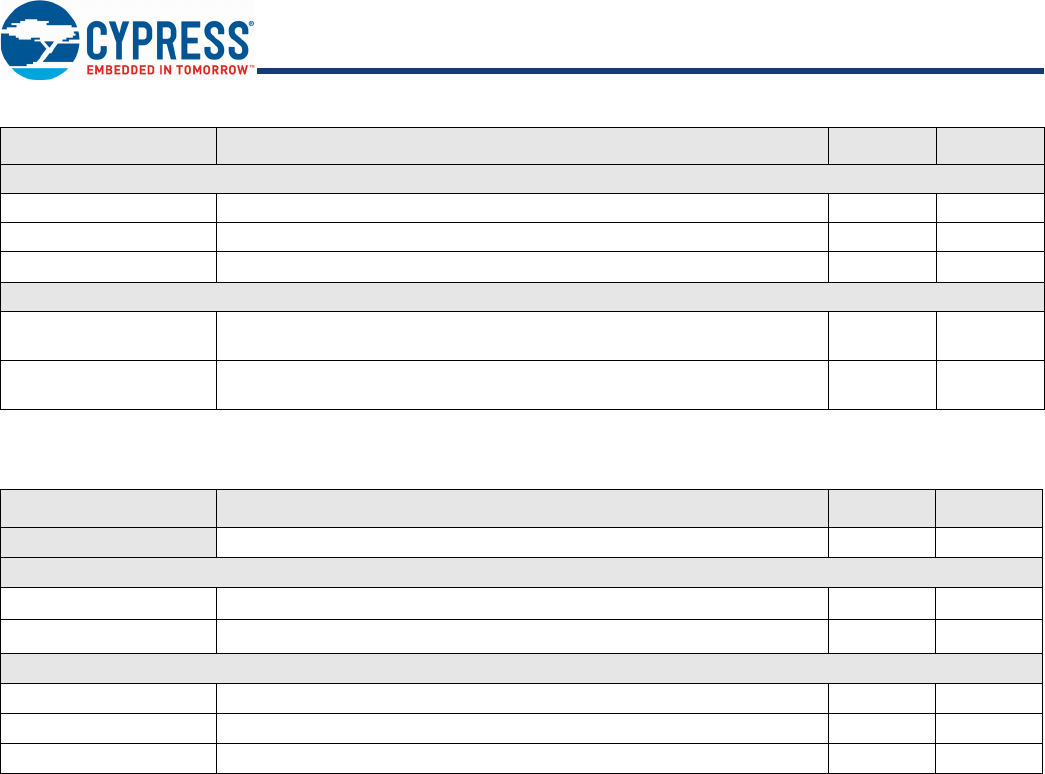
Document Number: 002-23132 Rev. ** Page 25 of 50
PRELIMINARY CYBT-353027-02
Sniff Slave
n11.25 ms – 4.95 mA
n22.5 ms – 2.6 mA
n495.00 ms Based on one attempt and no timeout. 254 μA
Transmit
n1 Mbps Peak current level during the transmission of a basic-rate packet: GFSK
output power = 10 dBm. 60.289 mA
nEDR Peak current level during the transmission of a 2 or 3 Mbps rate packet. EDR
output power = 8 dBm. 52.485 mA
Table 14. Bluetooth and BLE Chipset Current Consumption, Class 2 (0 dBm)
Mode Remarks Typ. Unit
3DH5/3DH5 – 31.57 mA
BLE
nBLE ADV Unconnectable 1.00 sec 174 μA
nBLE Scan No devices present. A 1.28 second interval with a scan window of 11.25 ms 368 μA
DMx/DHx
nDM1/DH1 – 27.5 mA
nDM3/DH3 – 31.34 mA
nDM5/DH5 – 32.36 mA
Table 13. Bluetooth, BLE, BR and EDR Chipset Current Consumption, Class 1
Mode Remarks Typ Unit
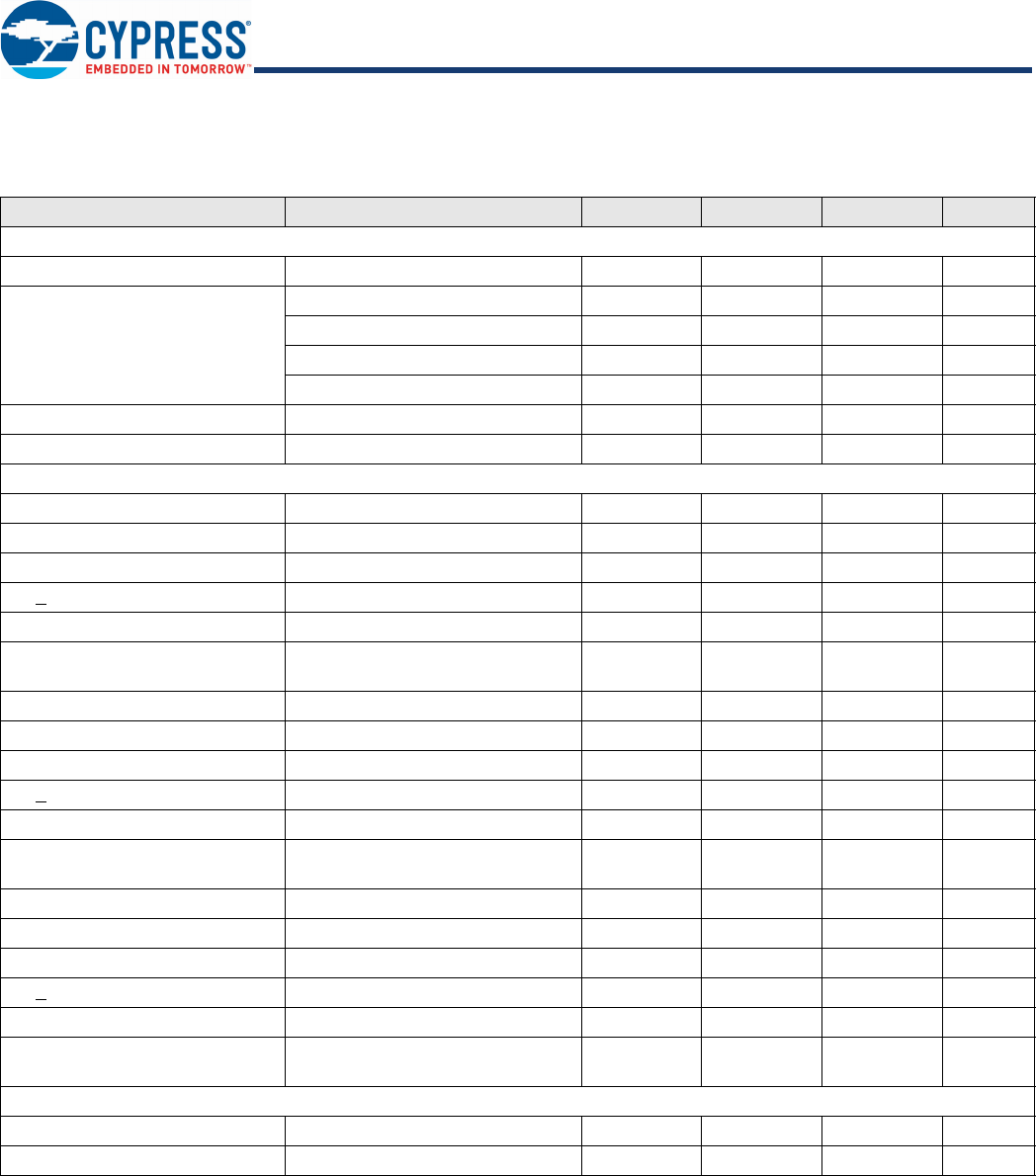
Document Number: 002-23132 Rev. ** Page 26 of 50
PRELIMINARY CYBT-353027-02
Chipset RF Specifications
All specifications in Table 15 are for industrial temperatures and are single-ended. Unused inputs are left open.
Table 15. Chipset Receiver RF Specifications
Parameter Conditions Minimum Typical[6] Maximum Unit
General
Frequency range – 2402 – 2480 MHz
RX sensitivity[7]
GFSK, 0.1% BER, 1 Mbps – –93.5 – dBm
LE GFSK, 0.1% BER, 1 Mbps – –96.5 – dBm
π/4-DQPSK, 0.01% BER, 2 Mbps – –95.5 – dBm
8-DPSK, 0.01% BER, 3 Mbps – –89.5 – dBm
Maximum input GFSK, 1 Mbps – – –20 dBm
Maximum input π/4-DQPSK, 8-DPSK, 2/3 Mbps – – –20 dBm
Interference Performance
C/I cochannel GFSK, 0.1% BER – 9.5 11 dB
C/I 1 MHz adjacent channel GFSK, 0.1% BER – –5 0 dB
C/I 2 MHz adjacent channel GFSK, 0.1% BER – –40 –30.0 dB
C/I > 3 MHz adjacent channel GFSK, 0.1% BER – –49 –40.0 dB
C/I image channel GFSK, 0.1% BER – –27 –9.0 dB
C/I 1 MHz adjacent to image
channel GFSK, 0.1% BER – –37 –20.0 dB
C/I cochannel π/4-DQPSK, 0.1% BER – 11 13 dB
C/I 1 MHz adjacent channel π/4-DQPSK, 0.1% BER – –8 0 dB
C/I 2 MHz adjacent channel π/4-DQPSK, 0.1% BER – –40 –30.0 dB
C/I > 3 MHz adjacent channel 8-DPSK, 0.1% BER – –50 –40.0 dB
C/I image channel π/4-DQPSK, 0.1% BER – –27 –7.0 dB
C/I 1 MHz adjacent to image
channel π/4-DQPSK, 0.1% BER – –40 –20.0 dB
C/I cochannel 8-DPSK, 0.1% BER – 17 21 dB
C/I 1 MHz adjacent channel 8-DPSK, 0.1% BER – –5 5 dB
C/I 2 MHz adjacent channel 8-DPSK, 0.1% BER – –40 –25.0 dB
C/I > 3 MHz adjacent channel 8-DPSK, 0.1% BER – –47 –33.0 dB
C/I Image channel 8-DPSK, 0.1% BER – –20 0 dB
C/I 1 MHz adjacent to image
channel 8-DPSK, 0.1% BER – –35 –13.0 dB
Out-of-Band Blocking Performance (CW)[8]
30 MHz–2000 MHz 0.1% BER – –10.0 – dBm
2000–2399 MHz 0.1% BER – –27 – dBm
Notes
6. Typical operating conditions are 1.22-V operating voltage and 25°C ambient temperature.
7. The receiver sensitivity is measured at BER of 0.1% on the device interface.
8. Meets this specification using front-end band pass filter.
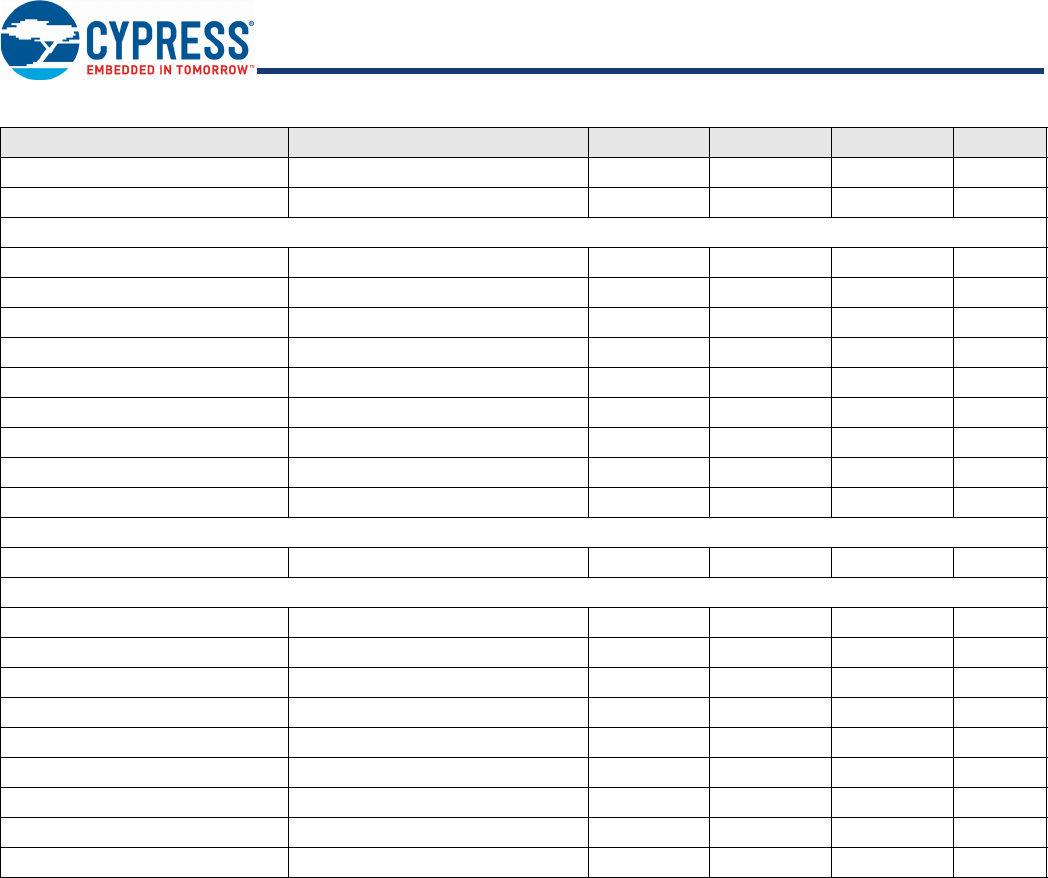
Document Number: 002-23132 Rev. ** Page 27 of 50
PRELIMINARY CYBT-353027-02
2498–3000 MHz 0.1% BER – –27 – dBm
3000 MHz–12.75 GHz 0.1% BER – –10.0 – dBm
Out-of-Band Blocking Performance, Modulated Interferer
776–764 MHz CDMA – –10[9] –dBm
824–849 MHz CDMA – –10[9] –dBm
1850–1910 MHz CDMA – –23[9] –dBm
824–849 MHz EDGE/GSM – –10[9] –dBm
880–915 MHz EDGE/GSM – –10[9] –dBm
1710–1785 MHz EDGE/GSM – –23[9] –dBm
1850–1910 MHz EDGE/GSM – –23[9] –dBm
1850–1910 MHz WCDMA – –23[9] –dBm
1920–1980 MHz WCDMA – –23[9] –dBm
Intermodulation Performance[10]
BT, Df = 5 MHz – –39.0 – – dBm
Spurious Emissions[11]
30 MHz to 1 GHz – – – –62 dBm
1 GHz to 12.75 GHz – – – –47 dBm
65 MHz to 108 MHz FM Rx – –147 – dBm/Hz
746 MHz to 764 MHz CDMA – –147 – dBm/Hz
851–894 MHz CDMA – –147 – dBm/Hz
925–960 MHz EDGE/GSM – –147 – dBm/Hz
1805–1880 MHz EDGE/GSM – –147 – dBm/Hz
1930–1990 MHz PCS – –147 – dBm/Hz
2110–2170 MHz WCDMA – –147 – dBm/Hz
Table 15. Chipset Receiver RF Specifications (continued)
Parameter Conditions Minimum Typical[6] Maximum Unit
Notes
9. Numbers are referred to the pin output with an external BPF filter.
10. f0 = -64 dBm Bluetooth-modulated signal, f1 = –39 dBm sine wave, f2 = –39 dBm Bluetooth-modulated signal, f0 = 2f1 – f2, and |f2 – f1| = n*1 MHz, where n is 3, 4,
or 5. For the typical case, n = 4.
11. Includes baseband radiated emissions.
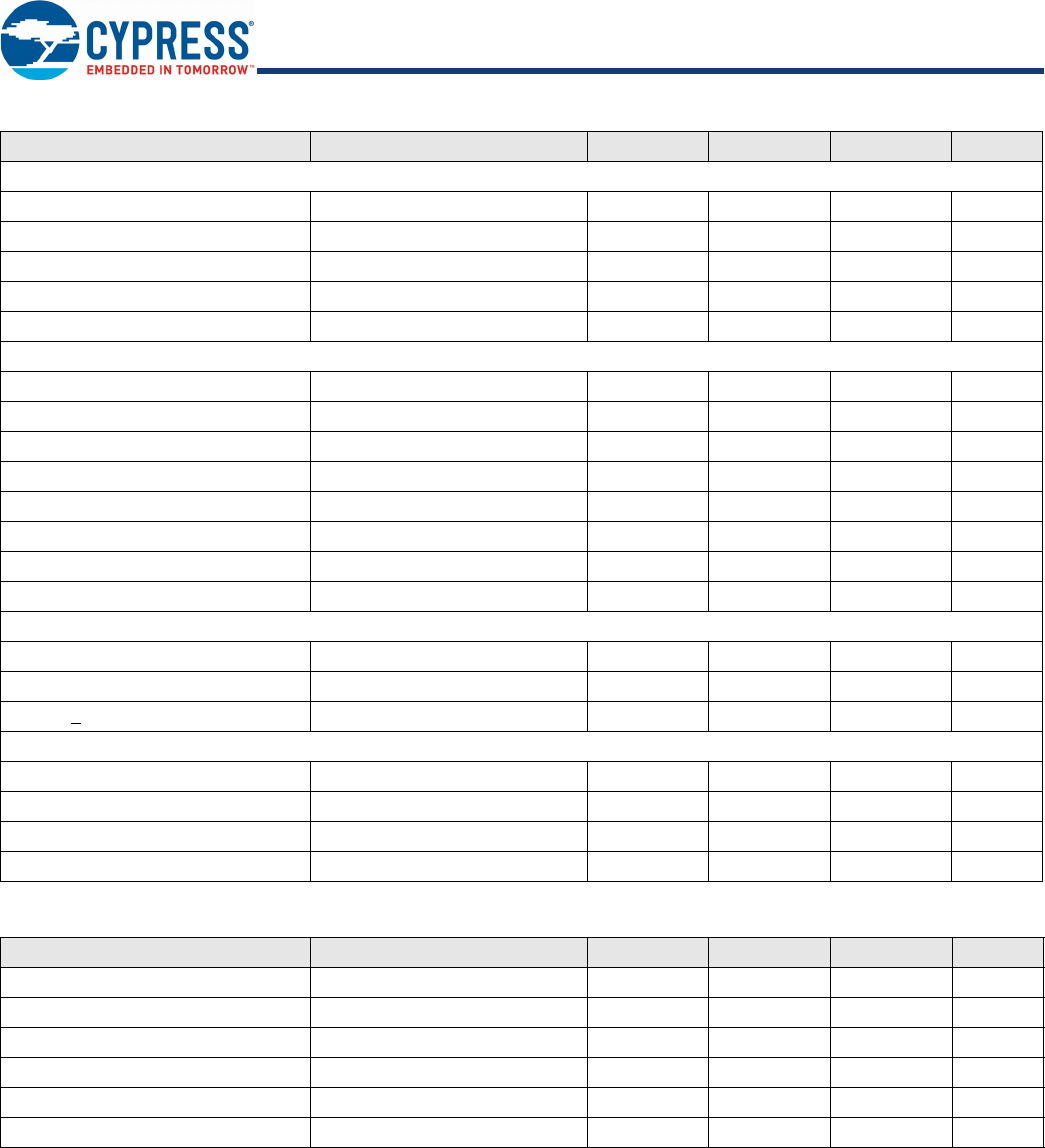
Document Number: 002-23132 Rev. ** Page 28 of 50
PRELIMINARY CYBT-353027-02
Table 16. Chipset Transmitter RF Specifications
Table 17. Chipset BLE RF Specifications
Parameter Conditions Minimum Typical Maximum Unit
General
Frequency range – 2402 – 2480 MHz
Class1: GFSK Tx power[12] ––12–dBm
Class1: EDR Tx power[13] ––9–dBm
Class 2: GFSK Tx power – – 2 – dBm
Power control step – 2 4 8 dB
Modulation Accuracy
π/4-DQPSK Frequency Stability – –10 – 10 kHz
π/4-DQPSK RMS DEVM – – – 20 %
π/4-QPSK Peak DEVM – – – 35 %
π/4-DQPSK 99% DEVM – – – 30 %
8-DPSK frequency stability – –10 – 10 kHz
8-DPSK RMS DEVM – – – 13 %
8-DPSK Peak DEVM – – – 25 %
8-DPSK 99% DEVM – – – 20 %
In-Band Spurious Emissions
1.0 MHz < |M – N| < 1.5 MHz – – – –26 dBc
1.5 MHz < |M – N| < 2.5 MHz – – – –20 dBm
|M – N| > 2.5 MHz – – – –40 dBm
Out-of-Band Spurious Emissions
30 MHz to 1 GHz – – – –36.0[14] dBm
1 GHz to 12.75 GHz – – – –30.0[14, 15] dBm
1.8 GHz to 1.9 GHz – – – –47.0 dBm
5.15 GHz to 5.3 GHz – – – –47.0 dBm
Parameter Conditions Minimum Typical Maximum Unit
Frequency range N/A 2402 – 2480 MHz
Rx sense[16] GFSK, 0.1% BER, 1 Mbps – –96.5 – dBm
Tx power[17] N/A –9–dBm
Mod Char: Delta F1 average N/A 225 255 275 kHz
Mod Char: Delta F2 max[18] N/A 99.9 – – %
Mod Char: Ratio N/A 0.8 0.95 – %
12. TBD dBm output for GFSK measured with PAVDD = 2.5 V.
13. TBD dBm output for EDR measured with PAVDD = 2.5 V.
14. Maximum value is the value required for Bluetooth qualification.
15. Meets this spec using a front-end band-pass filter.
16. Dirty Tx is Off.
17. The BLE Tx power can be increased to compensate for front-end losses such as BPF, diplexer, switch, etc. The output is capped at 12 dBm out. The BLE Tx power
at the antenna port cannot exceed the 10 dBm EIRP specification limit.
18. At least 99.9% of all delta F2 max frequency values recorded over 10 packets must be greater than 185 kHz.
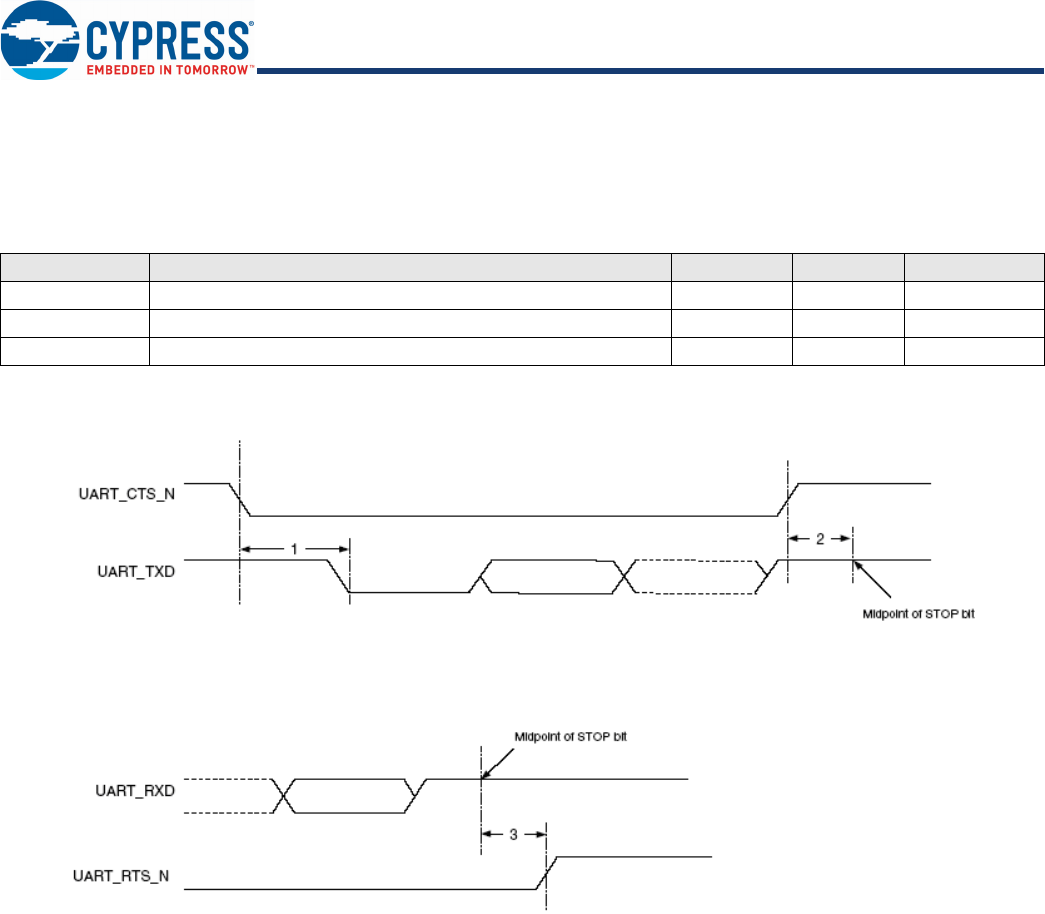
Document Number: 002-23132 Rev. ** Page 29 of 50
PRELIMINARY CYBT-353027-02
Timing and AC Characteristics
In this section, use the numbers listed in the Reference column of each table to interpret the following timing diagrams.
UART Timing
Figure 12. UART Timing
Table 18. UART Timing Specifications
Reference Characteristics Min Max Unit
1 Delay time, UART_CTS_N low to UART_TXD valid – 24 Baud out cycles
2 Setup time, UART_CTS_N high before midpoint of stop bit – 10 ns
3 Delay time, midpoint of stop bit to UART_RTS_N high – 2 Baud out cycles
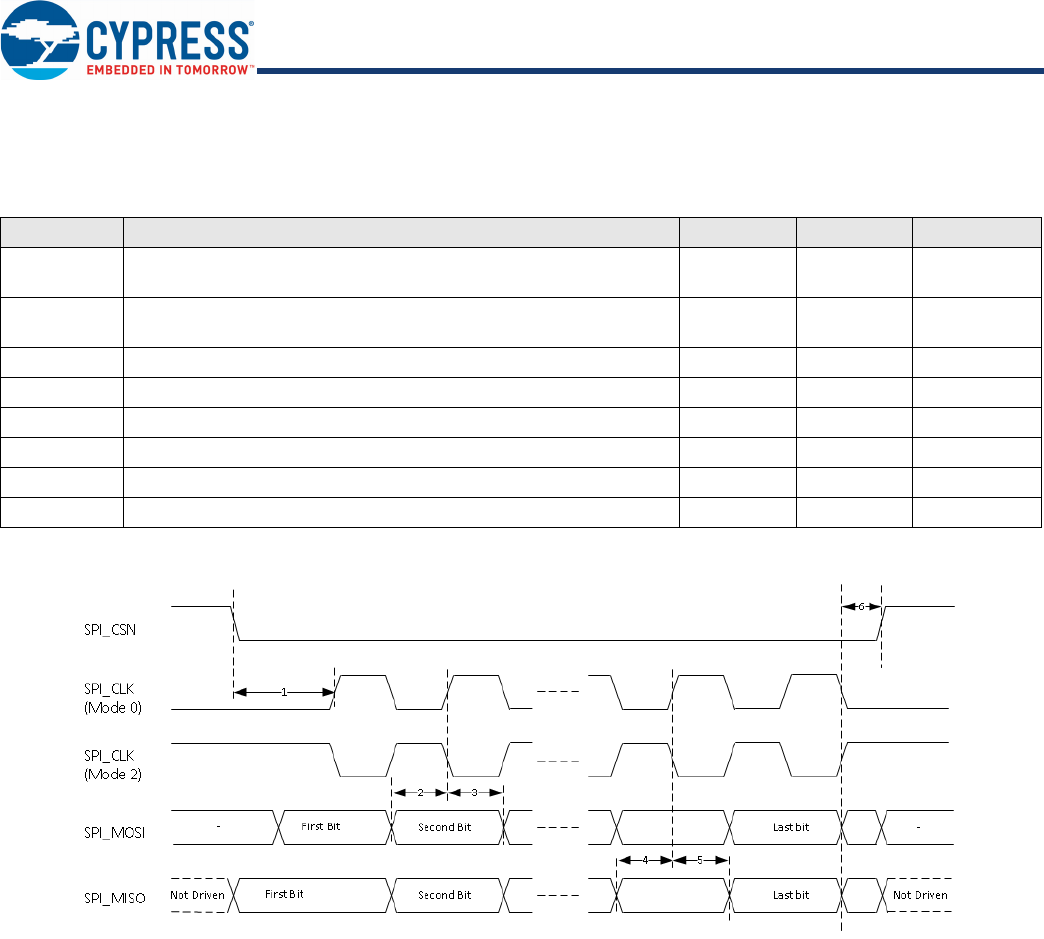
Document Number: 002-23132 Rev. ** Page 30 of 50
PRELIMINARY CYBT-353027-02
SPI Timing
The SPI interface supports clock speeds up to 12 MHz
Tab le 19 and Figure 13 show the timing requirements when operating in SPI Mode 0 and 2, and SPI Mode 1 and 3, respectively.
Table 19. SPI Mode 0 and 2
Figure 13. SPI Timing – Mode 0 and 2
Tab le 20 and Figure 14 show the timing requirements when operating in SPI Mode 1 and 3.
Reference Characteristics Minimum Maximum Unit
1Time from slave assert SPI_INT to master assert SPI_CSN (Direc-
tRead) 0∞ns
2Time from master assert SPI_CSN to slave assert SPI_INT (Direct-
Write) 0∞ns
3 Time from master assert SPI_CSN to first clock edge 20 ∞ns
4 Setup time for MOSI data lines 8 ½ SCK ns
5 Hold time for MOSI data lines 8 ½ SCK ns
6 Time from last sample on MOSI/MISO to slave deassert SPI_INT 0 100 ns
7 Time from slave deassert SPI_INT to master deassert SPI_CSN 0 ∞ns
8 Idle time between subsequent SPI transactions 1 SCK ∞ns
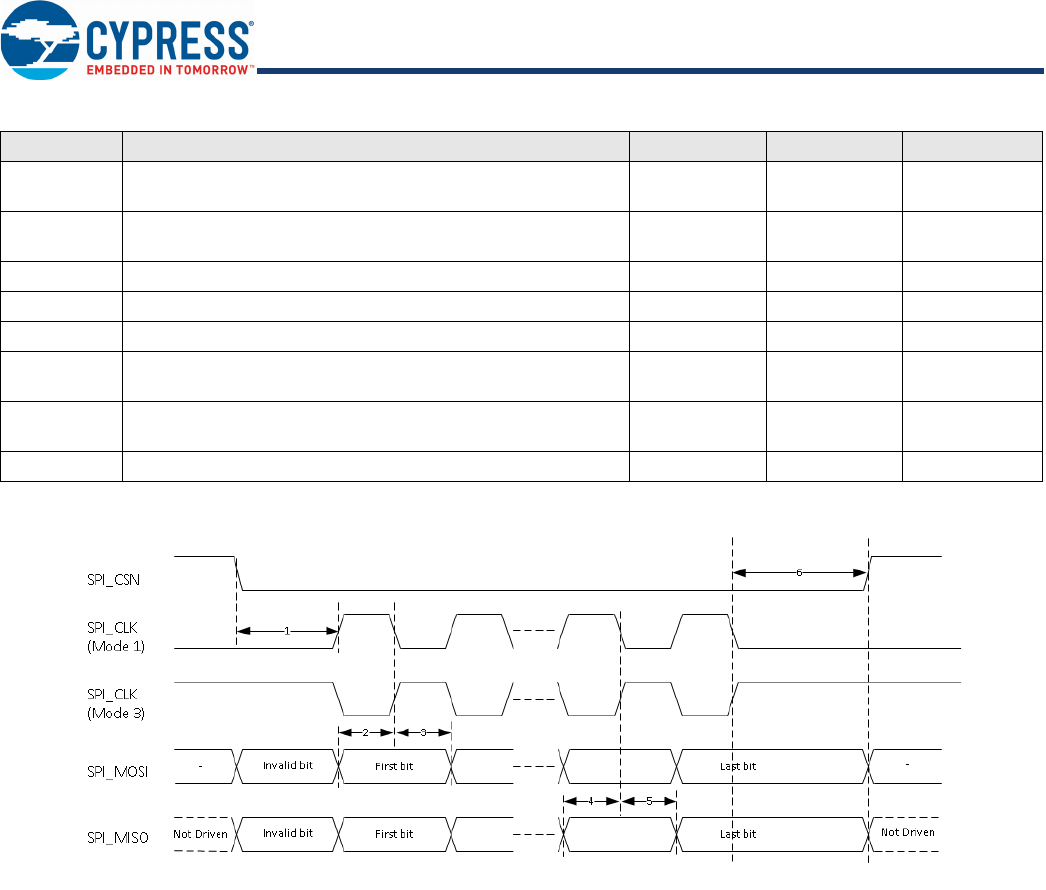
Document Number: 002-23132 Rev. ** Page 31 of 50
PRELIMINARY CYBT-353027-02
Table 20. SPI Mode 1 and 3
Figure 14. SPI Timing – Mode 1 and 3
Reference Characteristics Minimum Maximum Unit
1Time from slave assert SPI_INT to master assert
SPI_CSN (DirectRead) 0∞ns
2Time from master assert SPI_CSN to slave assert
SPI_INT (DirectWrite) 0∞ns
3 Time from master assert SPI_CSN to first clock edge 20 ∞ns
4 Setup time for MOSI data lines 8 ½ SCK ns
5 Hold time for MOSI data lines 8 ½ SCK ns
6Time from last sample on MOSI/MISO to slave
deassert SPI_INT 0 100 ns
7Time from slave deassert SPI_INT to master
deassert SPI_CSN 0∞ns
8 Idle time between subsequent SPI transactions 1 SCK ∞ns
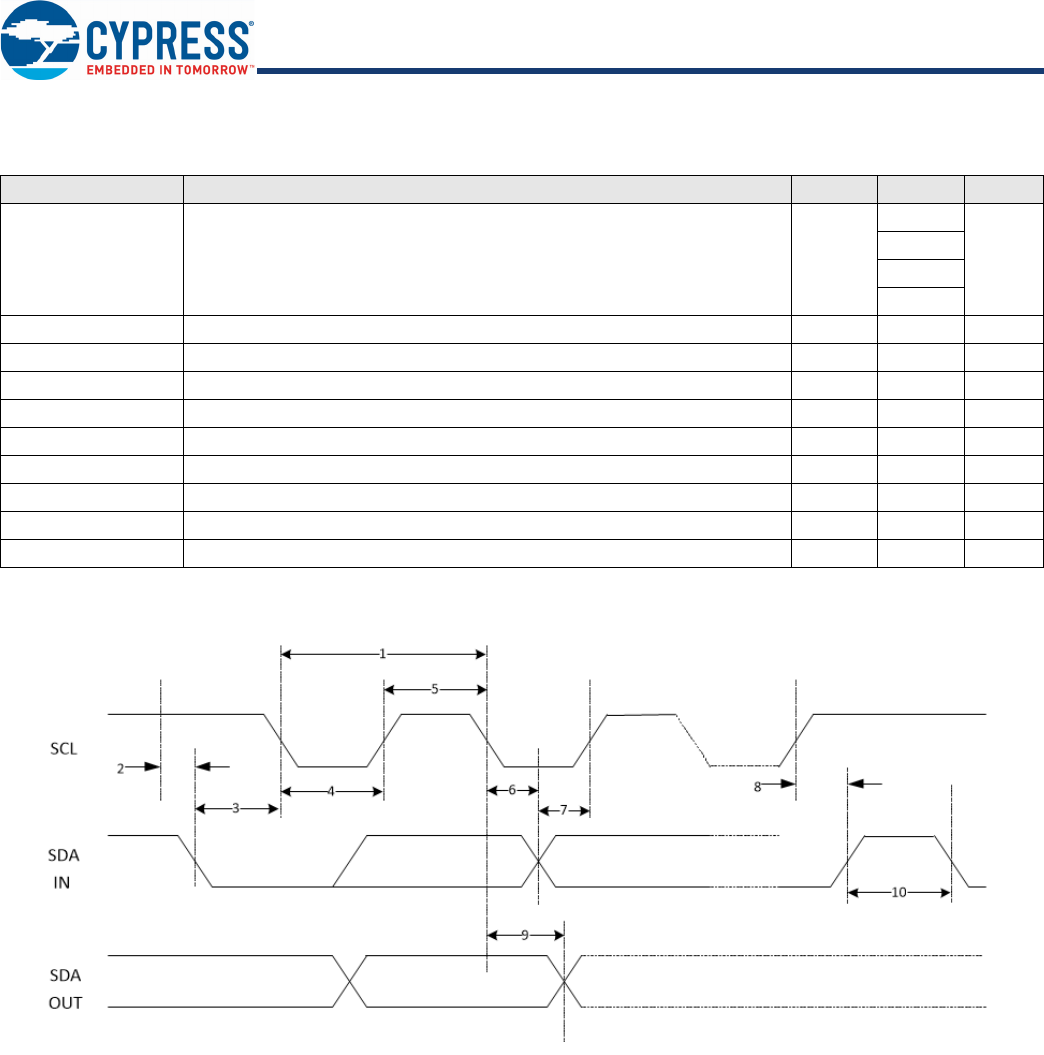
Document Number: 002-23132 Rev. ** Page 32 of 50
PRELIMINARY CYBT-353027-02
BSC Interface Timing
Figure 15. BSC Interface Timing Diagram
Table 21. BSC Interface Timing Specifications
Reference Characteristics Min Max Unit
1 Clock frequency – 100 kHz
400
800
1000
2 START condition setup time 650 – ns
3 START condition hold time 280 – ns
4 Clock low time 650 – ns
5 Clock high time 280 – ns
6 Data input hold time[19] 0 – ns
7 Data input setup time 100 – ns
8 STOP condition setup time 280 – ns
9 Output valid from clock – 400 ns
10 Bus free time[20] 650 – ns
Notes
19. As a transmitter, 125 ns of delay is provided to bridge the undefined region of the falling edge of SCL to avoid unintended generation of START or STOP conditions.
20. Time that the cbus must be free before a new transaction can start.
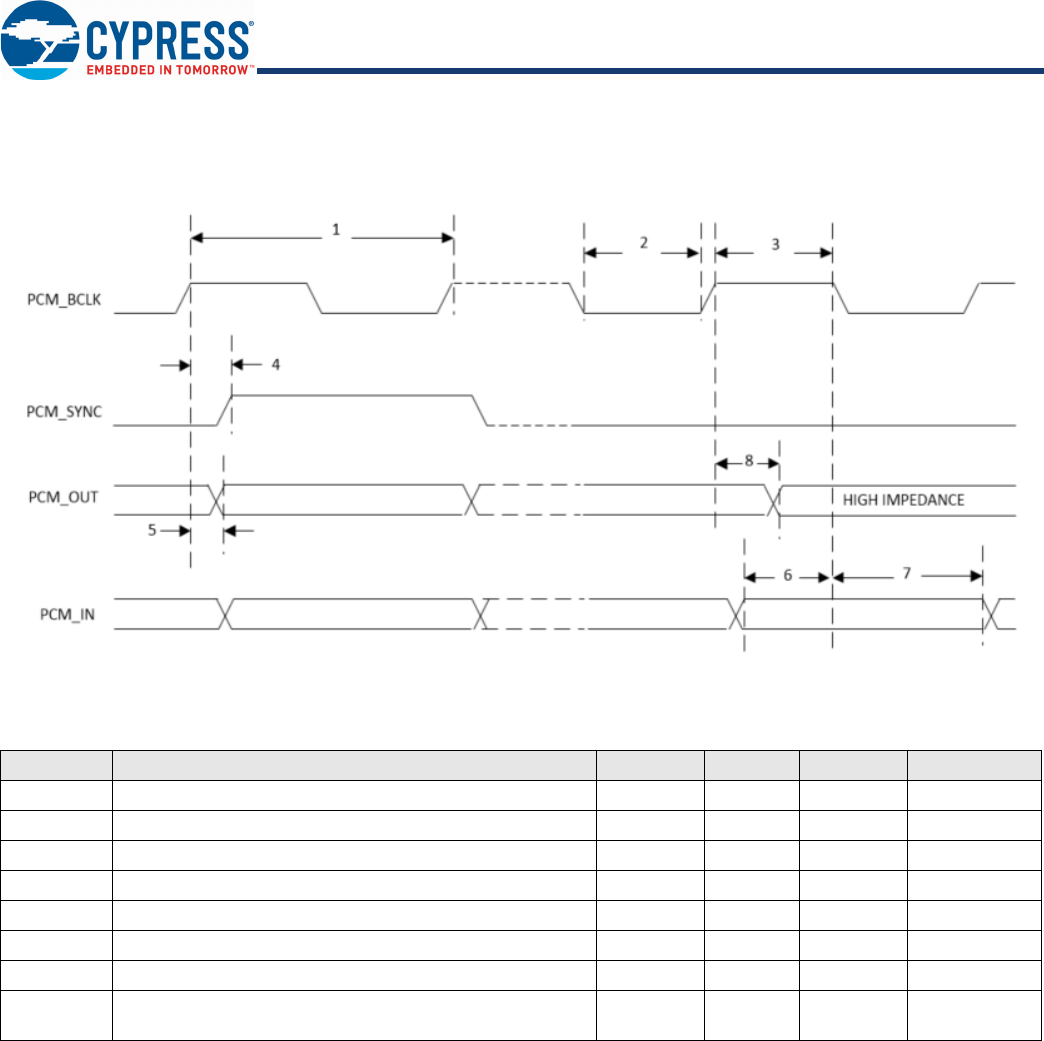
Document Number: 002-23132 Rev. ** Page 33 of 50
PRELIMINARY CYBT-353027-02
PCM Interface Timing
Short Frame Sync, Master Mode
Figure 16. PCM Timing Diagram (Short Frame Sync, Master Mode)
Table 22. PCM Interface Timing Specifications (Short Frame Sync, Master Mode)
Reference Characteristics Minimum Typical Maximum Unit
1 PCM bit clock frequency – – 20.0 MHz
2 PCM bit clock LOW 20.0 – – ns
3 PCM bit clock HIGH 20.0 – – ns
4 PCM_SYNC delay 0 – 5.7 ns
5 PCM_OUT delay –0.4 – 5.6 ns
6 PCM_IN setup 16.9 – – ns
7 PCM_IN hold 25.0 – – ns
8Delay from rising edge of PCM_BCLK during last bit period
to PCM_OUT becoming high impedance –0.4 – 5.6 ns
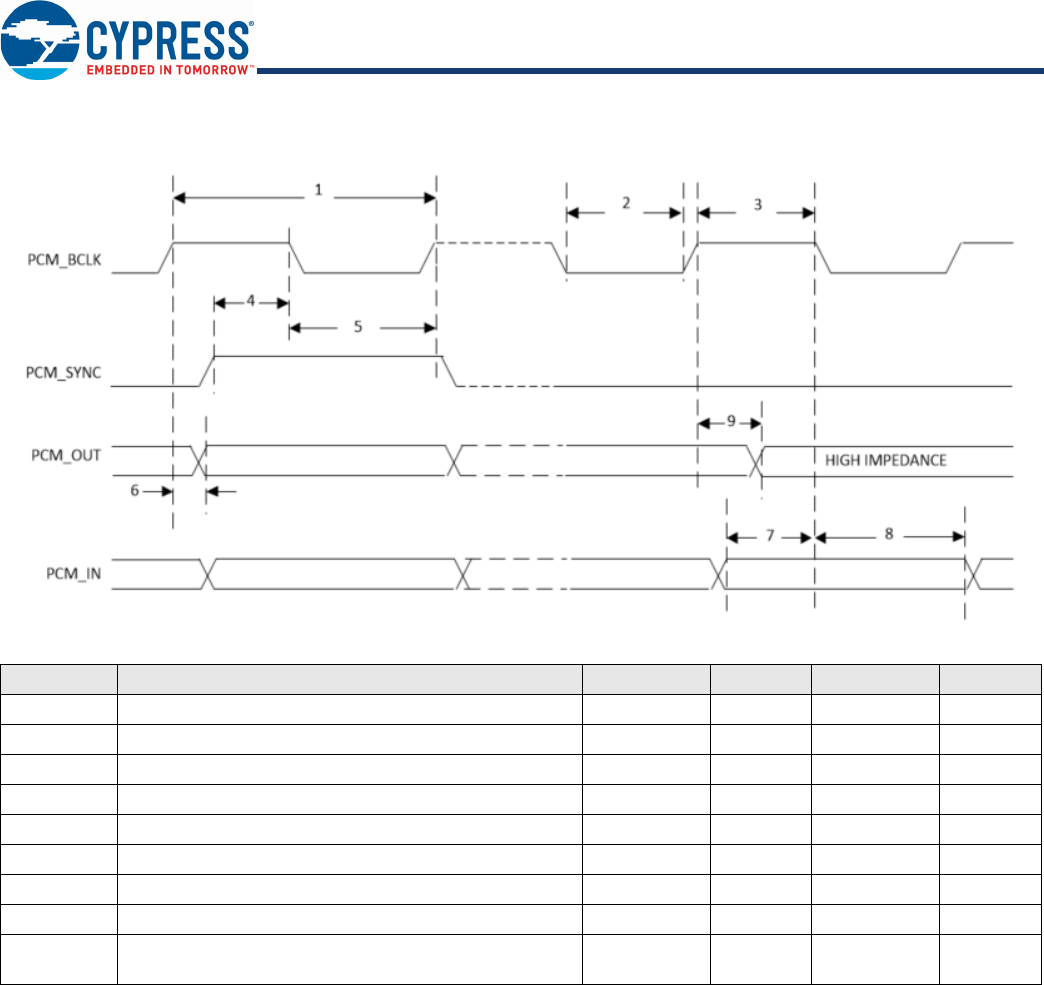
Document Number: 002-23132 Rev. ** Page 34 of 50
PRELIMINARY CYBT-353027-02
Short Frame Sync, Slave Mode
Figure 17. PCM Timing Diagram (Short Frame Sync, Slave Mode)
Table 23. PCM Interface Timing Specifications (Short Frame Sync, Slave Mode)
Reference Characteristics Minimum Typical Maximum Unit
1 PCM bit clock frequency – – TBD MHz
2 PCM bit clock LOW TBD – – ns
3 PCM bit clock HIGH TBD – – ns
4 PCM_SYNC setup TBD – – ns
5 PCM_SYNC hold TBD – – ns
6 PCM_OUT delay TBD – TBD ns
7 PCM_IN setup TBD – – ns
8 PCM_IN hold TBD – – ns
9Delay from rising edge of PCM_BCLK during last bit period
to PCM_OUT becoming high impedance TBD – TBD ns
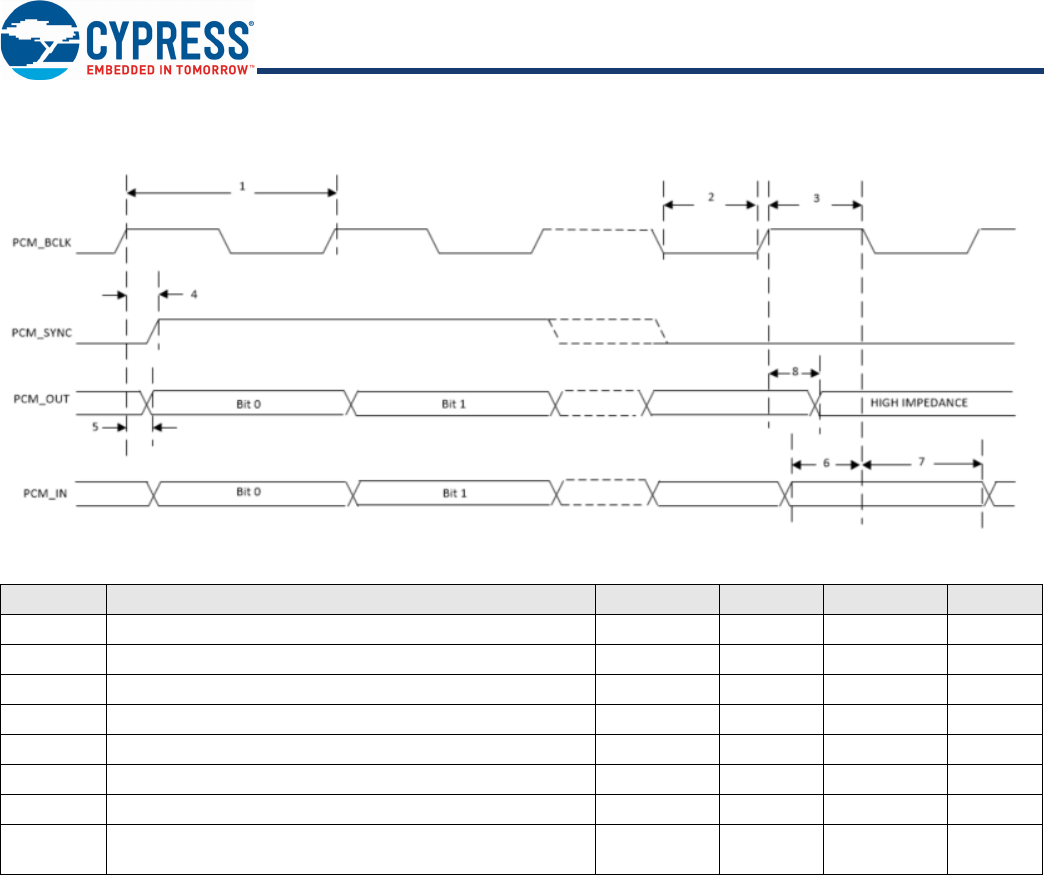
Document Number: 002-23132 Rev. ** Page 35 of 50
PRELIMINARY CYBT-353027-02
Long Frame Sync, Master Mode
Figure 18. PCM Timing Diagram (Long Frame Sync, Master Mode)
Table 24. PCM Interface Timing Specifications (Long Frame Sync, Master Mode)
Reference Characteristics Minimum Typical Maximum Unit
1 PCM bit clock frequency – – TBD MHz
2 PCM bit clock LOW TBD – – ns
3 PCM bit clock HIGH TBD – – ns
4 PCM_SYNC delay TBD – TBD ns
5 PCM_OUT delay TBD – TBD ns
6 PCM_IN setup TBD – – ns
7 PCM_IN hold TBD – – ns
8Delay from rising edge of PCM_BCLK during last bit period
to PCM_OUT becoming high impedance TBD – TBD ns
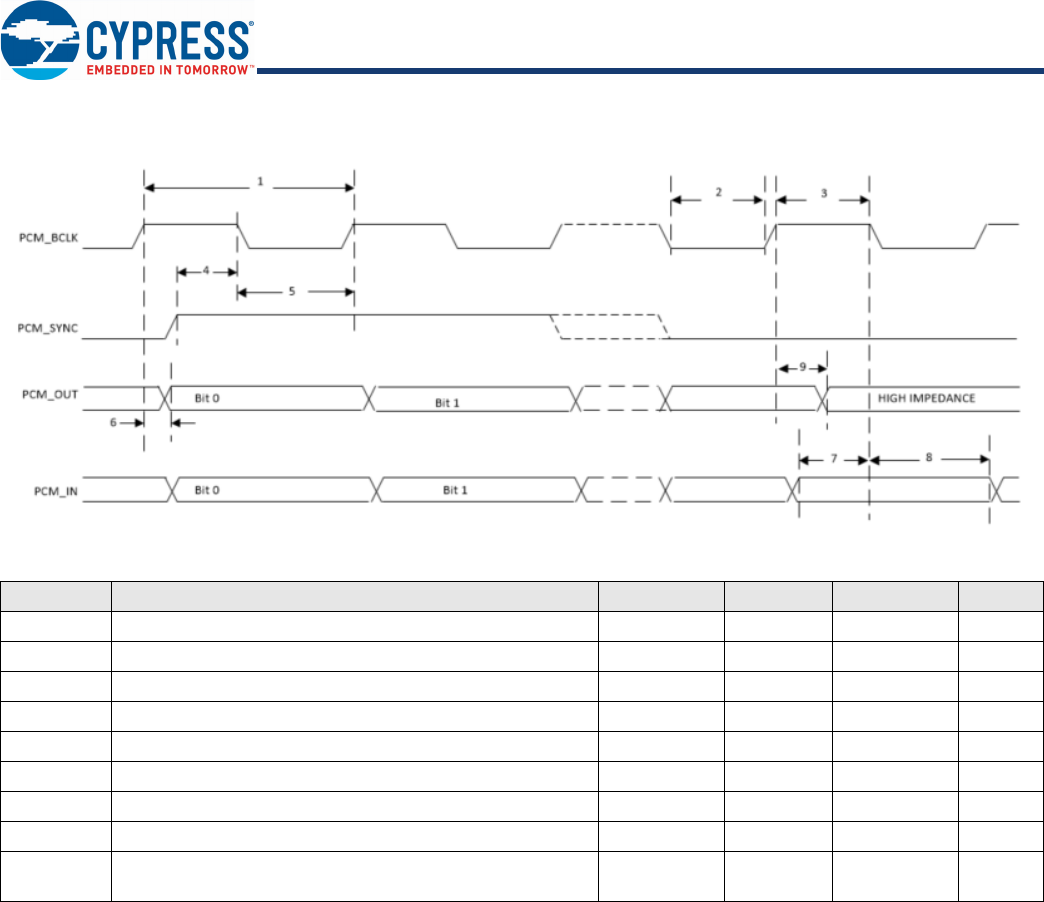
Document Number: 002-23132 Rev. ** Page 36 of 50
PRELIMINARY CYBT-353027-02
Long Frame Sync, Slave Mode
Figure 19. PCM Timing Diagram (Long Frame Sync, Slave Mode)
Table 25. PCM Interface Timing Specifications (Long Frame Sync, Slave Mode)
Reference Characteristics Minimum Typical Maximum Unit
1 PCM bit clock frequency – – TBD MHz
2 PCM bit clock LOW TBD – – ns
3 PCM bit clock HIGH TBD – – ns
4 PCM_SYNC setup TBD – – ns
5 PCM_SYNC hold TBD – – ns
6 PCM_OUT delay TBD – TBD ns
7 PCM_IN setup TBD – – ns
8 PCM_IN hold TBD – – ns
9Delay from rising edge of PCM_BCLK during last bit period
to PCM_OUT becoming high impedance TBD – TBD ns

Document Number: 002-23132 Rev. ** Page 37 of 50
PRELIMINARY CYBT-353027-02
I2S Interface Timing
The I2S interface supports both master and slave modes. The I2S signals are:
nI2S clock: I2S SCK
nI2S Word Select: I2S WS
nI2S Data Out: I2S SDO
nI2S Data In: I2S SDI
I2S SCK and I2S WS become outputs in master mode and inputs in slave mode, while I2S SDO always stays as an output. The channel
word length is 16 bits and the data is justified so that the MSB of the left-channel data is aligned with the MSB of the I2S bus, per the
I2S specification. The MSB of each data word is transmitted one bit clock cycle after the I2S WS transition, synchronous with the falling
edge of bit clock. Left-channel data is transmitted when I2S WS is low, and right-channel data is transmitted when I2S WS is high.
Data bits sent by the CYBT-013033-01 are synchronized with the falling edge of I2S_SCK and should be sampled by the receiver on
the rising edge of I2S_SSCK.
The clock rate in master mode is either of the following:
n48 kHz x 32 bits per frame = 1.536 MHz
n48 kHz x 50 bits per frame = 2.400 MHz
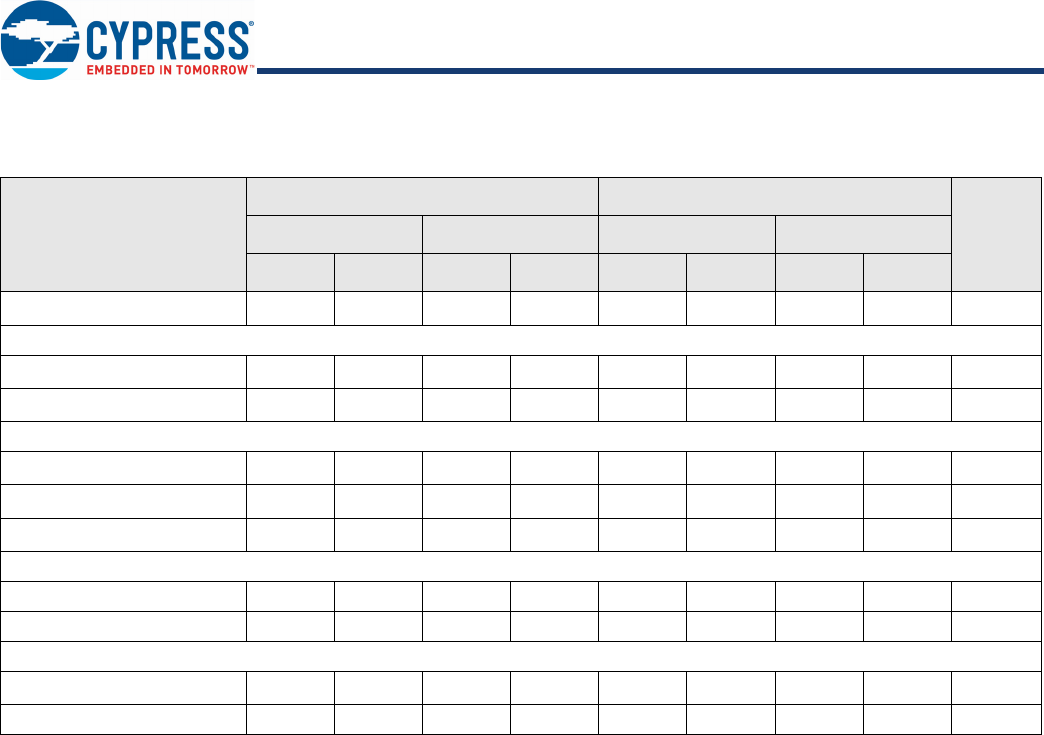
Document Number: 002-23132 Rev. ** Page 38 of 50
PRELIMINARY CYBT-353027-02
The master clock is generated from the input reference clock using a N/M clock divider. In the slave mode, any clock rate is supported
to a maximum of 3.072 MHz. Timing values specified in Ta b l e 2 6 are relative to high and low threshold levels.
Table 26. Timing for I2S Transmitters and Receivers
Transmitter Receiver
Notes
Lower LImit Upper Limit Lower Limit Upper Limit
Min Max Min Max Min Max Min Max
Clock Period T Ttr –––
Tr– – – Note 21
Master Mode: Clock generated by transmitter or receiver
HIGH tHC 0.35Ttr –––
0.35Ttr – – – Note 22
LOWtLC 0.35Ttr –––
0.35Ttr – – – Note 22
Slave Mode: Clock accepted by transmitter or receiver
HIGH tHC –0.35Ttr –––
0.35Ttr – – Note 23
LOW tLC –0.35Ttr –––
0.35Ttr – – Note 23
Rise time tRC ––
0.15Ttr – – – – Note 24
Transmitter
Delay tdtr –––0.8T––––Note 25
Hold time thtr 0–––––––Note 25
Receiver
Setup time tsr –––––
0.2Tr– – Note 26
Hold time thr –––––0––Note 26
Notes
21. The system clock period T must be greater than Ttr and Tr because both the transmitter and receiver have to be able to handle the data transfer rate.
22. At all data rates in master mode, the transmitter or receiver generates a clock signal with a fixed mark/space ratio. For this reason, tHC and tLC are specified with
respect to T.
23. In slave mode, the transmitter and receiver need a clock signal with minimum HIGH and LOW periods so that they can detect the signal. So long as the minimum
periods are greater than 0.35Tr, any clock that meets the requirements can be used.
24. Because the delay (tdtr) and the maximum transmitter speed (defined by Ttr) are related, a fast transmitter driven by a slow clock edge can result in tdtr not exceeding
tRC which means thtr becomes zero or negative. Therefore, the transmitter has to guarantee that thtr is greater than or equal to zero, so long as the clock rise-time
tRC is not more than tRCmax, where tRCmax is not less than 0.15Ttr.
25. To allow data to be clocked out on a falling edge, the delay is specified with respect to the rising edge of the clock signal and T, always giving the receiver sufficient
setup time.
26. The data setup and hold time must not be less than the specified receiver setup and hold time.
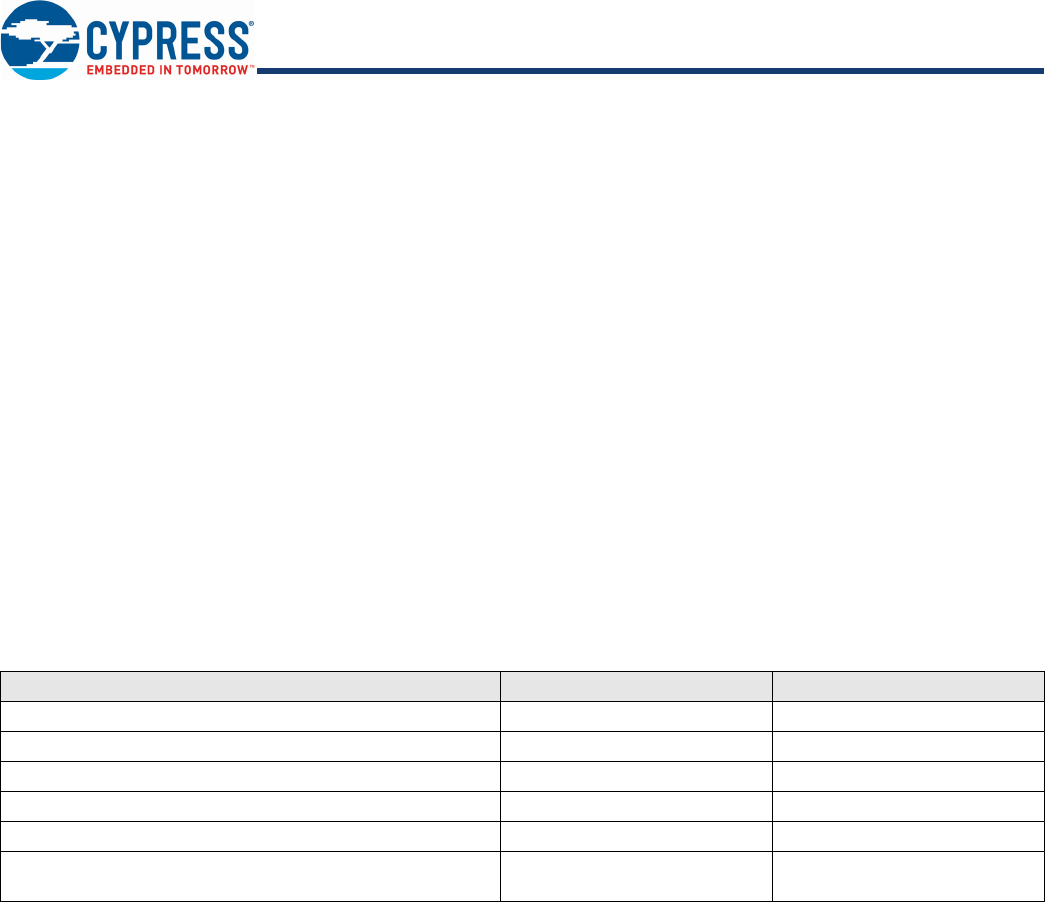
Document Number: 002-23132 Rev. ** Page 39 of 50
PRELIMINARY CYBT-353027-02
Environmental Specifications
Environmental Compliance
This CYBT-353027-02 BLE module is produced in compliance with the Restriction of Hazardous Substances (RoHS) and
Halogen-Free (HF) directives. The Cypress module and components used to produce this module are RoHS and HF compliant.
RF Certification
The CYBT-353027-02 module will be certified under the following RF certification standards at production release.
nFCC: WAP3027
nCE
nIC: 7922A-3027
nMIC: TBD
Safety Certification
The CYBT-353027-02 module complies with the following safety regulations:
nUnderwriters Laboratories, Inc. (UL): Filing E331901
nCSA
nTUV
Environmental Conditions
Tab le 27 describes the operating and storage conditions for the Cypress BLE module.
ESD and EMI Protection
Exposed components require special attention to ESD and electromagnetic interference (EMI).
A grounded conductive layer inside the device enclosure is suggested for EMI and ESD performance. Any openings in the enclosure
near the module should be surrounded by a grounded conductive layer to provide ESD protection and a low-impedance path to ground.
Device Handling: Proper ESD protocol must be followed in manufacturing to ensure component reliability.
Table 27. Environmental Conditions for CYBT-353027-02
Description Minimum Specification Maximum Specification
Operating temperature -30 °C 85 °C
Operating humidity (relative, non-condensation) 5% 85%
Thermal ramp rate – 3 °C/minute
Storage temperature –40 °C 85 °C
Storage temperature and humidity – 85 °C at 85%
ESD: Module integrated into end system
Components[27] –15 kV Air
2.0 kV Contact
Note
27. This does not apply to the RF pins (ANT).

Document Number: 002-23132 Rev. ** Page 40 of 50
PRELIMINARY CYBT-353027-02
Regulatory Information
FCC
FCC NOTICE:
The device CYBT-353027-02 complies with Part 15 of the FCC Rules. The device meets the requirements for modular transmitter
approval as detailed in FCC public Notice DA00-1407.transmitter Operation is subject to the following two conditions: (1) This device
may not cause harmful interference, and (2) This device must accept any interference received, including interference that may cause
undesired operation.
CAUTION:
The FCC requires the user to be notified that any changes or modifications made to this device that are not expressly approved by
Cypress Semiconductor may void the user's authority to operate the equipment.
This equipment has been tested and found to comply with the limits for a Class B digital device, pursuant to Part 15 of the FCC Rules.
These limits are designed to provide reasonable protection against harmful interference in a residential installation. This equipment
generates uses and can radiate radio frequency energy and, if not installed and used in accordance with the instructions, may cause
harmful interference to radio communications. However, there is no guarantee that interference will not occur in a particular installation.
If this equipment does cause harmful interference to radio or television reception, which can be determined by turning the equipment
off and on, the user is encouraged to try to correct the interference by one or more of the following measures:
nReorient or relocate the receiving antenna.
nIncrease the separation between the equipment and receiver.
nConnect the equipment into an outlet on a circuit different from that to which the receiver is connected.
nConsult the dealer or an experienced radio/TV technician for help
LABELING REQUIREMENTS:
The Original Equipment Manufacturer (OEM) must ensure that FCC labelling requirements are met. This includes a clearly visible
label on the outside of the OEM enclosure specifying the appropriate Cypress Semiconductor FCC identifier for this product as well
as the FCC Notice above. The FCC identifier is FCC ID: WAP3027.
In any case the end product must be labeled exterior with "Contains FCC ID: 7922A-3027"
ANTENNA WARNING:
This device is tested with a standard SMA connector and with the antenna listed in Table 6 on page 13. When integrated in the OEMs
product, these fixed antennas require installation preventing end-users from replacing them with non-approved antennas. Any antenna
not in the following table must be tested to comply with FCC Section 15.203 for unique antenna connectors and Section 15.247 for
emissions.
RF EXPOSURE:
To comply with FCC RF Exposure requirements, the Original Equipment Manufacturer (OEM) must ensure to install the approved
antenna in the previous.
The preceding statement must be included as a CAUTION statement in manuals, for products operating with the approved antenna
in Table 6 on page 13, to alert users on FCC RF Exposure compliance. Any notification to the end user of installation or removal
instructions about the integrated radio module is not allowed.
The radiated output power of CYBT-353027-02 with the trace antenna is far below the FCC radio frequency exposure limits. Never-
theless, use CYBT-353027-02 in such a manner that minimizes the potential for human contact during normal operation.
End users may not be provided with the module installation instructions. OEM integrators and end users must be provided with
transmitter operating conditions for satisfying RF exposure compliance.

Document Number: 002-23132 Rev. ** Page 41 of 50
PRELIMINARY CYBT-353027-02
ISED
Innovation, Science and Economic Development Canada (ISED) Certification
CYBT-353027-02 is licensed to meet the regulatory requirements of Innovation, Science and Economic Development Canada (ISED),
License: IC: 7922A-3027
Manufacturers of mobile, fixed or portable devices incorporating this module are advised to clarify any regulatory questions and ensure
compliance for SAR and/or RF exposure limits. Users can obtain Canadian information on RF exposure and compliance from
www.ic.gc.ca.
This device has been designed to operate with the antennas listed in Table 6 on page 13, having a maximum gain of -0.5 dBi. Antennas
not included in this list or having a gain greater than -0.5 dBi are strictly prohibited for use with this device. The required antenna
impedance is 50 ohms. The antenna used for this transmitter must not be co-located or operating in conjunction with any other antenna
or transmitter.
ISED NOTICE:
The device CYBT-353027-02 including the built-in trace antenna complies with Canada RSS-GEN Rules. The device meets the
requirements for modular transmitter approval as detailed in RSS-GEN. Operation is subject to the following two conditions: (1) This
device may not cause harmful interference, and (2) This device must accept any interference received, including interference that
may cause undesired operation.
L'appareil CYBT-353027-02, y compris l'antenne intégrée, est conforme aux Règles RSS-GEN de Canada. L'appareil répond aux
exigences d'approbation de l'émetteur modulaire tel que décrit dans RSS-GEN. L'opération est soumise aux deux conditions
suivantes: (1) Cet appareil ne doit pas causer d'interférences nuisibles, et (2) Cet appareil doit accepter toute interférence reçue, y
compris les interférences pouvant entraîner un fonctionnement indésirable.
ISED INTERFERENCE STATEMENT FOR CANADA
This device complies with Innovation, Science and Economic Development (ISED) Canada licence-exempt RSS standard(s).
Operation is subject to the following two conditions: (1) this device may not cause interference, and (2) this device must accept any
interference, including interference that may cause undesired operation of the device.
Cet appareil est conforme à la norme sur l'innovation, la science et le développement économique (ISED) norme RSS exempte de
licence. L'exploitation est autorisée aux deux conditions suivantes: (1) l'appareil ne doit pas produire de brouillage, et (2) l'utilisateur
de l'appareil doit accepter tout brouillage radioélectrique subi, même si le brouillage est susceptible d'en compromettre le fonction-
nement.
ISED RADIATION EXPOSURE STATEMENT FOR CANADA
This equipment complies with ISED radiation exposure limits set forth for an uncontrolled environment.
Cet équipement est conforme aux limites d'exposition aux radiations ISED prévues pour un environnement incontrôlé.
LABELING REQUIREMENTS:
The Original Equipment Manufacturer (OEM) must ensure that ISED labelling requirements are met. This includes a clearly visible
label on the outside of the OEM enclosure specifying the appropriate Cypress Semiconductor IC identifier for this product as well as
the ISED Notices above. The IC identifier is TBD. In any case, the end product must be labeled in its exterior with "Contains
IC: 7922A-3027"
(3) SAR is not required for this module
as long as the distance is higher than 15mm away from user since the maximum output power is below IC threshold.
(3) Le SAR n'est pas requis pour ce module tant que la distance est supérieure à 15 mm par rapport à l'utilisateur,
car la puissance de sortie maximale est inférieure au seuil IC.

Document Number: 002-23132 Rev. ** Page 42 of 50
PRELIMINARY CYBT-353027-02
European Declaration of Conformity
Hereby, Cypress Semiconductor declares that the Bluetooth module CYBT-353027-02 complies with the essential requirements and
other relevant provisions of Directive 2014. As a result of the conformity assessment procedure described in Annex III of the Directive
2014, the end-customer equipment should be labeled as follows:
All versions of the CYBT-353027-02 in the specified reference design can be used in the following countries: Austria, Belgium, Cyprus,
Czech Republic, Denmark, Estonia, Finland, France, Germany, Greece, Hungary, Ireland, Italy, Latvia, Lithuania, Luxembourg, Malta,
Poland, Portugal, Slovakia, Slovenia, Spain, Sweden, The Netherlands, the United Kingdom, Switzerland, and Norway.
MIC Japan
CYBT-353027-02 is certified as a module with certification number TBD. End products that integrate CYBT-353027-02 do not need
additional MIC Japan certification for the end product.
End product can display the certification label of the embedded module.

Document Number: 002-23132 Rev. ** Page 43 of 50
PRELIMINARY CYBT-353027-02
Packaging
The CYBT-353027-02 is offered in tape and reel packaging. Figure 20 details the tape dimensions used for the CYBT-353027-02.
Figure 20. CYBT-353027-02 Tape Dimensions (TBD)
Figure 21 details the orientation of the CYBT-353027-02 in the tape as well as the direction for unreeling.
Figure 21. Component Orientation in Tape and Unreeling Direction (TBD)
Table 28. Solder Reflow Peak Temperature
Module Part Number Package Maximum Peak Temperature Maximum Time at Peak Temperature No. of Cycles
CYBT-353027-02 19-pad SMT 260 °C 30 seconds 2
Table 29. Package Moisture Sensitivity Level (MSL), IPC/JEDEC J-STD-2
Module Part Number Package MSL
CYBT-353027-02 19-pad SMT MSL 3
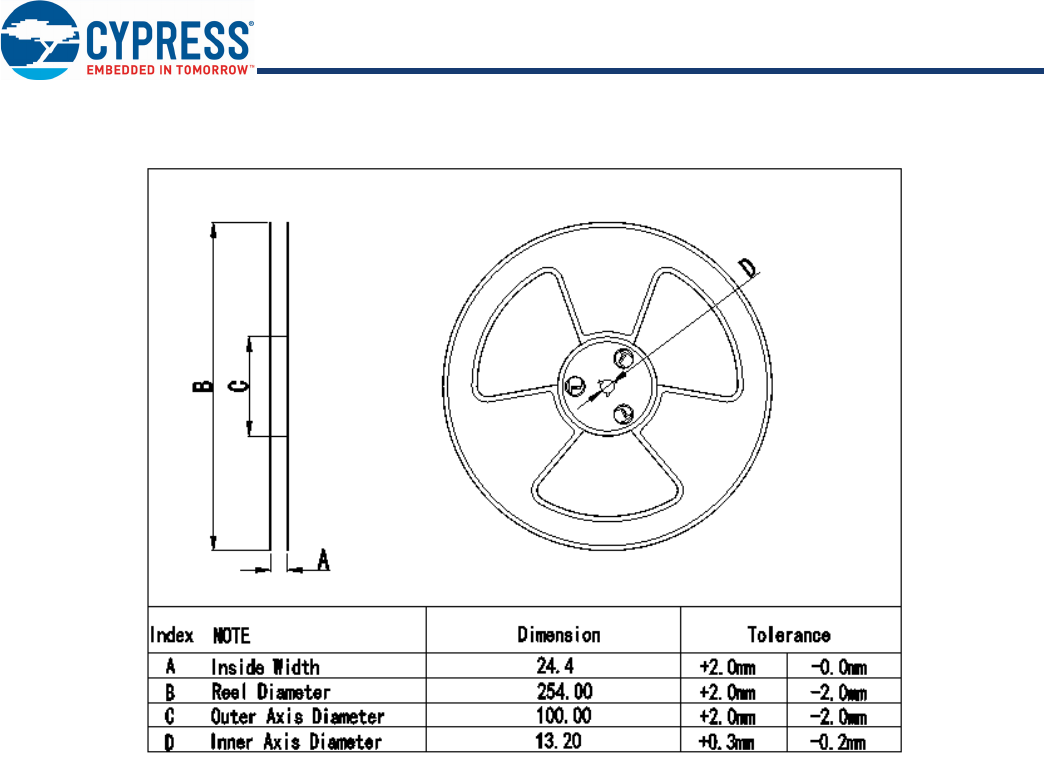
Document Number: 002-23132 Rev. ** Page 44 of 50
PRELIMINARY CYBT-353027-02
Figure 22 details reel dimensions used for the CYBT-353027-02.
Figure 22. Reel Dimensions
The CYBT-353027-02 is designed to be used with pick-and-place equipment in an SMT manufacturing environment. The
center-of-mass for the CYBT-353027-02 is detailed in Figure 23.
Figure 23. CYBT-353027-02 Center of Mass (TBD)
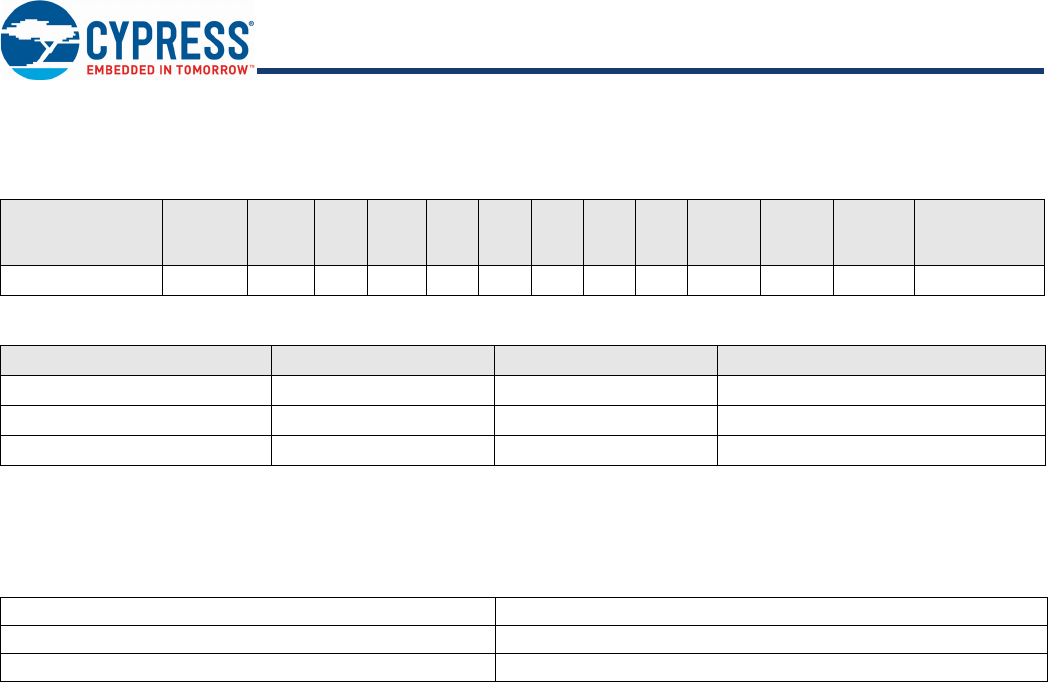
Document Number: 002-23132 Rev. ** Page 45 of 50
PRELIMINARY CYBT-353027-02
Ordering Information
Tab le 30 lists the CYBT-353027-02 part number and features. Table 31 lists the reel shipment quantities for the CYBT-353027-02.
The CYBT-353027-02 is offered in tape and reel packaging. The CYBT-353027-02 ships in a reel size of 500.
For additional information and a complete list of Cypress Semiconductor Wireless products, contact your local Cypress sales
representative. To locate the nearest Cypress office, visit our website.
Table 30. Ordering Information
Ordering Part
Number
Max CPU
Speed
(MHz)
SFlash
Size
(KB)
RAM
Size
(KB)
UART I2CSPI I2SPCM PWM ADC
Inputs GPIOs Package Packaging
CYBT-353027-02 24 512 352 Yes Yes Yes Yes Yes - 5 8 19-SMT Tape and Reel
Table 31. Tape and Reel Package Quantity and Minimum Order Amount
Description Minimum Reel Quantity Maximum Reel Quantity Comments
Reel Quantity 500 500 Ships in 500 unit reel quantities.
Minimum Order Quantity (MOQ) 500 – –
Order Increment (OI) 500 – –
U.S. Cypress Headquarters Address 198 Champion Court, San Jose, CA 95134
U.S. Cypress Headquarter Contact Info (408) 943-2600
Cypress website address http://www.cypress.com
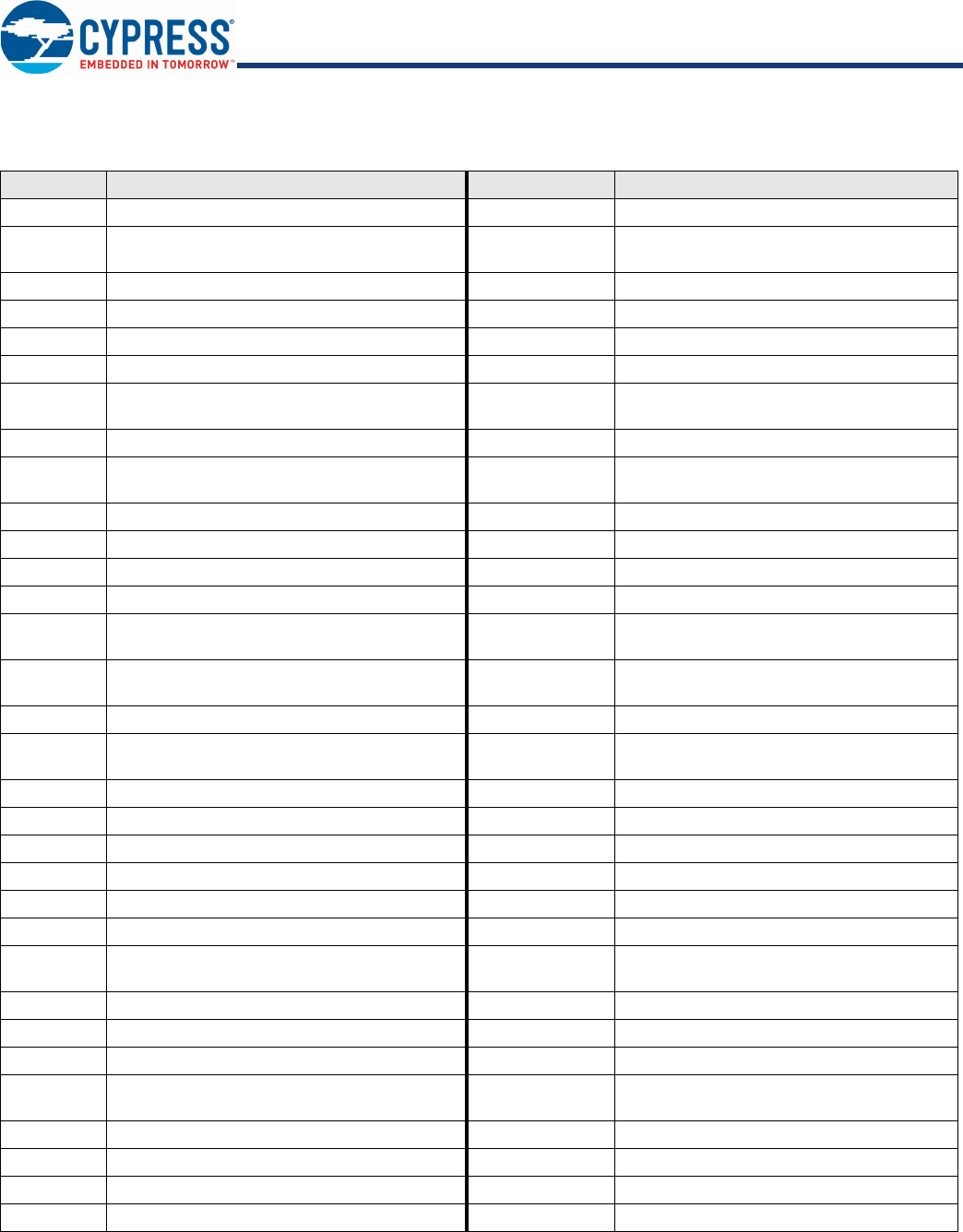
Document Number: 002-23132 Rev. ** Page 46 of 50
PRELIMINARY CYBT-353027-02
Acronyms
Table 32. Acronyms Used in this Document
Acronym Description Acronym Description
ADC analog-to-digital converter IDE integrated development environment
ALU arithmetic logic unit I2C, or IIC Inter-Integrated Circuit, a communications
protocol
AMUXBUS analog multiplexer bus IC Industry Canada
API application programming interface IIR infinite impulse response, see also FIR
ARM®advanced RISC machine, a CPU architecture ILO internal low-speed oscillator, see also IMO
BLE Bluetooth Low Energy IMO internal main oscillator, see also ILO
Bluetooth
SIG
Bluetooth Special Interest Group INL integral nonlinearity, see also DNL
BW bandwidth I/O input/output, see also GPIO, DIO, SIO, USBIO
CAN Controller Area Network, a communications
protocol
IPOR initial power-on reset
CE European Conformity IPSR interrupt program status register
CSA Canadian Standards Association IRQ interrupt request
CMRR common-mode rejection ratio ITM instrumentation trace macrocell
CPU central processing unit KC Korea Certification
CRC cyclic redundancy check, an error-checking
protocol
LCD liquid crystal display
ECC error correcting code LIN Local Interconnect Network, a communica-
tions protocol.
ECO external crystal oscillator LNA low noise amplifier
EEPROM electrically erasable programmable read-only
memory
LR link register
EMI electromagnetic interference LUT lookup table
EMIF external memory interface LVD low-voltage detect, see also LVI
EOC end of conversion LVI low-voltage interrupt, see also HVI
EOF end of frame LVTTL low-voltage transistor-transistor logic
ESD electrostatic discharge MAC multiply-accumulate
FCC Federal Communications Commission MCU microcontroller unit
FET field-effect transistor MIC Ministry of Internal Affairs and Communica-
tions (Japan)
FIR finite impulse response, see also IIR MISO master-in slave-out
FPB flash patch and breakpoint NC no connect
FS full-speed NMI nonmaskable interrupt
GPIO general-purpose input/output, applies to a PSoC
pin
NRZ non-return-to-zero
HCI host controller interface NVIC nested vectored interrupt controller
HVI high-voltage interrupt, see also LVI, LVD NVL nonvolatile latch, see also WOL
IC integrated circuit Opamp operational amplifier
IDAC current DAC, see also DAC, VDAC PA power amplifier
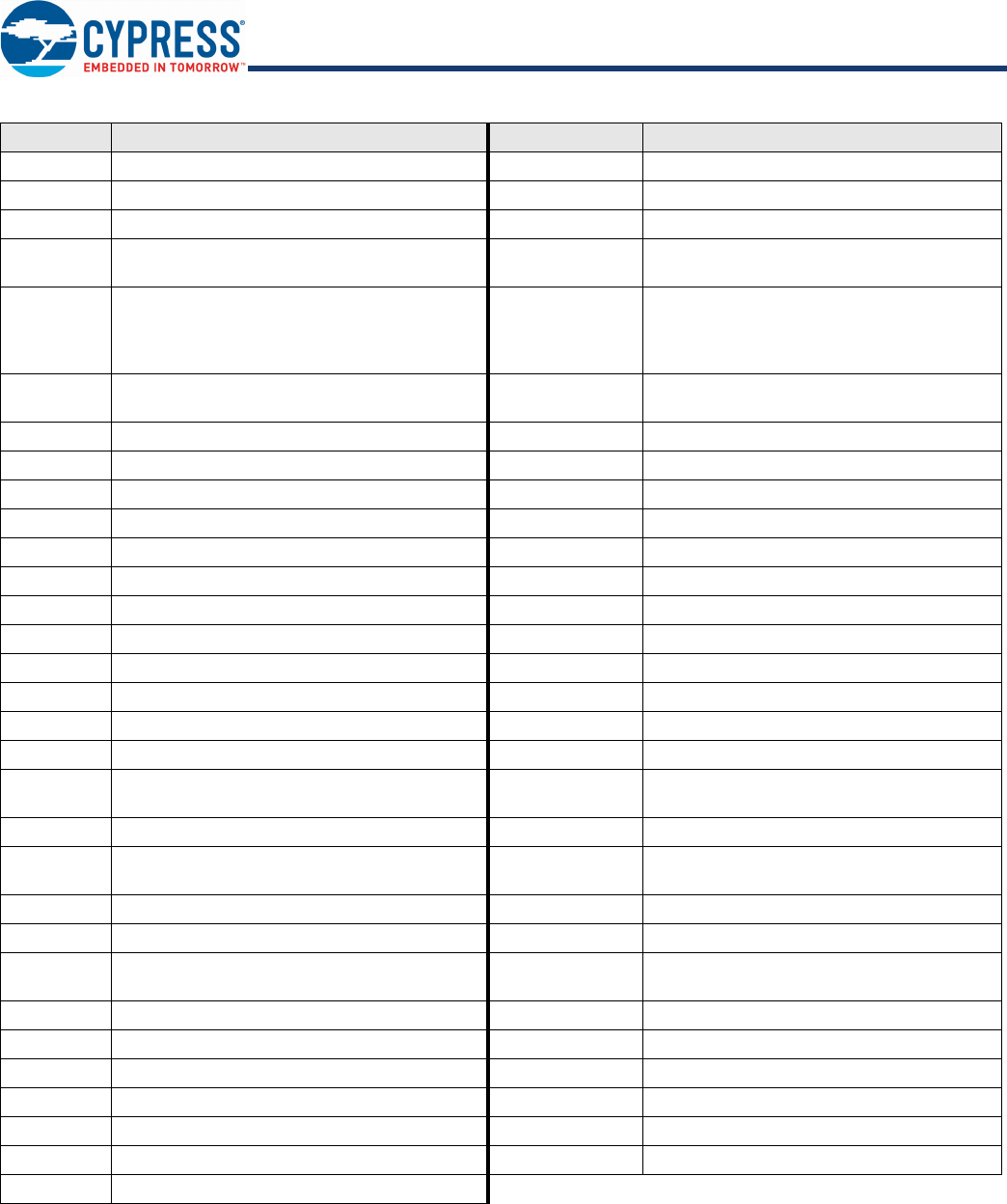
Document Number: 002-23132 Rev. ** Page 47 of 50
PRELIMINARY CYBT-353027-02
PAL programmable array logic, see also PLD SOF start of frame
PC program counter S/H sample and hold
PCB printed circuit board SINAD signal to noise and distortion ratio
PGA programmable gain amplifier SIO special input/output, GPIO with advanced
features. See GPIO.
PHUB peripheral hub SMT surface-mount technology; a method for
producing electronic circuitry in which the
components are placed directly onto the
surface of PCBs
PHY physical layer SPI Serial Peripheral Interface, a communications
protocol
PICU port interrupt control unit SR slew rate
PLA programmable logic array SRAM static random access memory
PLD programmable logic device, see also PAL SRES software reset
PLL phase-locked loop STN super twisted nematic
PMDD package material declaration data sheet SWD serial wire debug, a test protocol
POR power-on reset SWV single-wire viewer
PRES precise power-on reset TD transaction descriptor, see also DMA
PRS pseudo random sequence THD total harmonic distortion
PS port read data register TIA transimpedance amplifier
PSoC®Programmable System-on-Chip™ TN twisted nematic
PSRR power supply rejection ratio TRM technical reference manual
PWM pulse-width modulator TTL transistor-transistor logic
QDID qualification design ID TUV Germany: Technischer Überwachungs-Verein
(Technical Inspection Association)
RAM random-access memory TX transmit
RISC reduced-instruction-set computing UART Universal Asynchronous Transmitter Receiver,
a communications protocol
RMS root-mean-square UDB universal digital block
RTC real-time clock USB Universal Serial Bus
RTL register transfer language USBIO USB input/output, PSoC pins used to connect
to a USB port
RTR remote transmission request VDAC voltage DAC, see also DAC, IDAC
RX receive WDT watchdog timer
SAR successive approximation register WOL write once latch, see also NVL
SC/CT switched capacitor/continuous time WRES watchdog timer reset
SCL I2C serial clock XRES external reset I/O pin
SDA I2C serial data XTAL crystal
SOC start of conversion
Table 32. Acronyms Used in this Document (continued)
Acronym Description Acronym Description
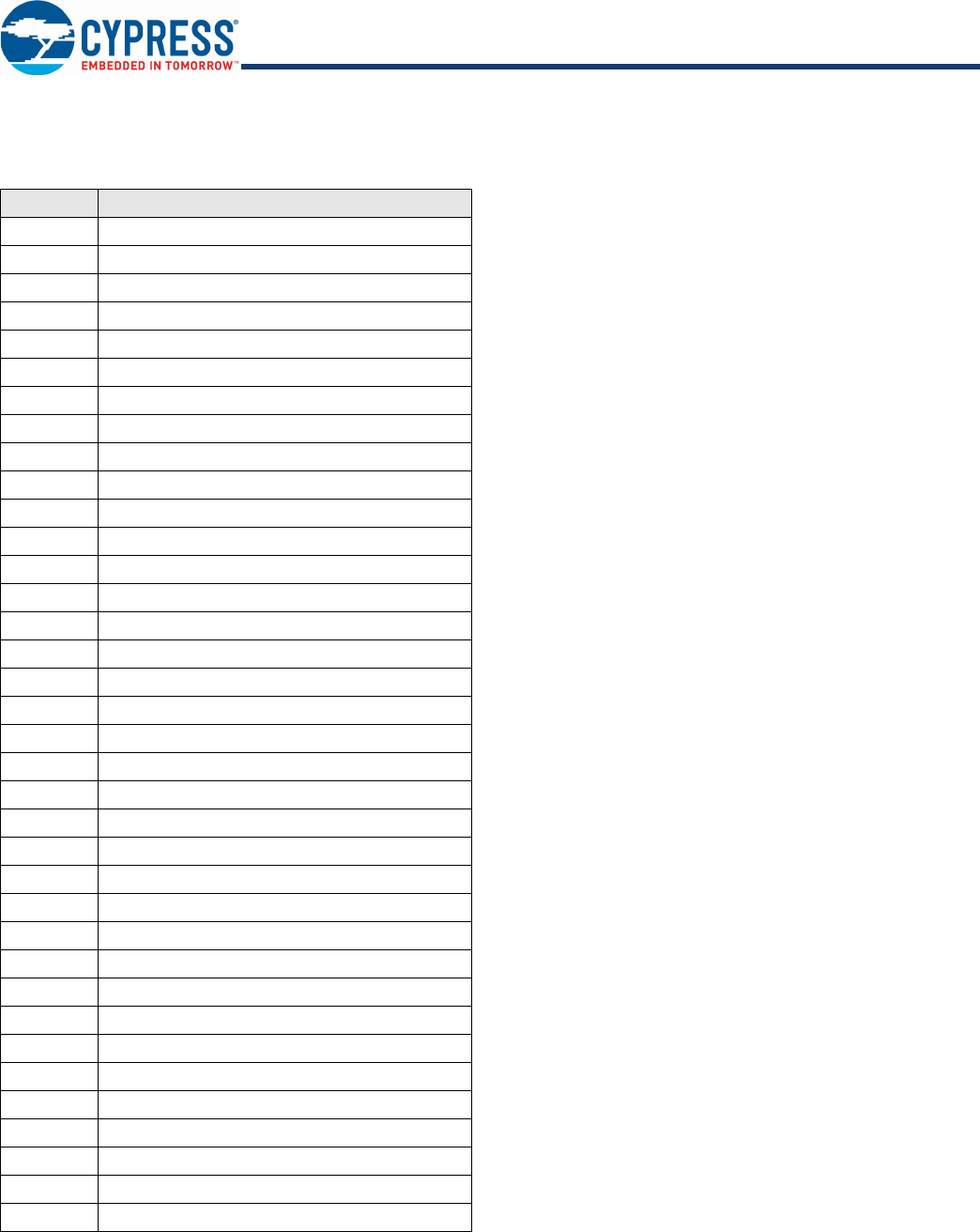
Document Number: 002-23132 Rev. ** Page 48 of 50
PRELIMINARY CYBT-353027-02
Document Conventions
Units of Measure
Table 33. Units of Measure
Symbol Unit of Measure
°C degrees Celsius
dB decibel
dBm decibel-milliwatts
fF femtofarads
Hz hertz
KB 1024 bytes
kbps kilobits per second
Khr kilohour
kHz kilohertz
kΩkilo ohm
ksps kilosamples per second
LSB least significant bit
Mbps megabits per second
MHz megahertz
MΩmega-ohm
Msps megasamples per second
µA microampere
µF microfarad
µH microhenry
µs microsecond
µV microvolt
µW microwatt
mA milliampere
ms millisecond
mV millivolt
nA nanoampere
ns nanosecond
nV nanovolt
Ωohm
pF picofarad
ppm parts per million
ps picosecond
s second
sps samples per second
sqrtHz square root of hertz
Vvolt
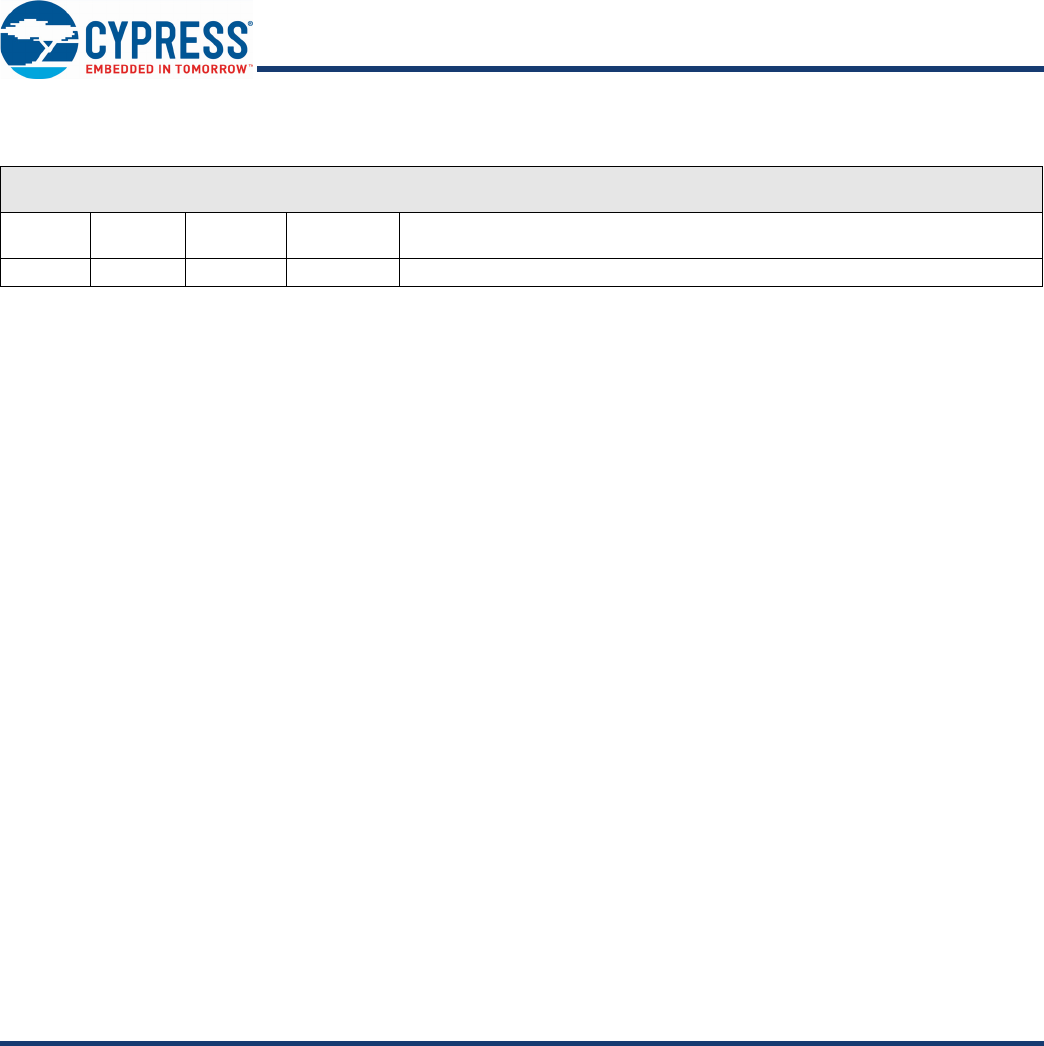
Document Number: 002-23132 Rev. ** Revised March 14, 2018 Page 49 of 50
PRELIMINARY CYBT-353027-02
© Cypress Semiconductor Corporation, 2018. This document is the property of Cypress Semiconductor Corporation and its subsidiaries, including Spansion LLC ("Cypress"). This document, including
any software or firmware included or referenced in this document ("Software"), is owned by Cypress under the intellectual property laws and treaties of the United States and other countries worldwide.
Cypress reserves all rights under such laws and treaties and does not, except as specifically stated in this paragraph, grant any license under its patents, copyrights, trademarks, or other intellectual
property rights. If the Software is not accompanied by a license agreement and you do not otherwise have a written agreement with Cypress governing the use of the Software, then Cypress hereby
grants you a personal, non-exclusive, nontransferable license (without the right to sublicense) (1) under its copyright rights in the Software (a) for Software provided in source code form, to modify and
reproduce the Software solely for use with Cypress hardware products, only internally within your organization, and (b) to distribute the Software in binary code form externally to end users (either
directly or indirectly through resellers and distributors), solely for use on Cypress hardware product units, and (2) under those claims of Cypress's patents that are infringed by the Software (as provided
by Cypress, unmodified) to make, use, distribute, and import the Software solely for use with Cypress hardware products. Any other use, reproduction, modification, translation, or compilation of the
Software is prohibited.
TO THE EXTENT PERMITTED BY APPLICABLE LAW, CYPRESS MAKES NO WARRANTY OF ANY KIND, EXPRESS OR IMPLIED, WITH REGARD TO THIS DOCUMENT OR ANY SOFTWARE
OR ACCOMPANYING HARDWARE, INCLUDING, BUT NOT LIMITED TO, THE IMPLIED WARRANTIES OF MERCHANTABILITY AND FITNESS FOR A PARTICULAR PURPOSE. To the extent
permitted by applicable law, Cypress reserves the right to make changes to this document without further notice. Cypress does not assume any liability arising out of the application or use of any
product or circuit described in this document. Any information provided in this document, including any sample design information or programming code, is provided only for reference purposes. It is
the responsibility of the user of this document to properly design, program, and test the functionality and safety of any application made of this information and any resulting product. Cypress products
are not designed, intended, or authorized for use as critical components in systems designed or intended for the operation of weapons, weapons systems, nuclear installations, life-support devices or
systems, other medical devices or systems (including resuscitation equipment and surgical implants), pollution control or hazardous substances management, or other uses where the failure of the
device or system could cause personal injury, death, or property damage ("Unintended Uses"). A critical component is any component of a device or system whose failure to perform can be reasonably
expected to cause the failure of the device or system, or to affect its safety or effectiveness. Cypress is not liable, in whole or in part, and you shall and hereby do release Cypress from any claim,
damage, or other liability arising from or related to all Unintended Uses of Cypress products. You shall indemnify and hold Cypress harmless from and against all claims, costs, damages, and other
liabilities, including claims for personal injury or death, arising from or related to any Unintended Uses of Cypress products.
Cypress, the Cypress logo, Spansion, the Spansion logo, and combinations thereof, WICED, PSoC, CapSense, EZ-USB, F-RAM, and Traveo are trademarks or registered trademarks of Cypress in
the United States and other countries. For a more complete list of Cypress trademarks, visit cypress.com. Other names and brands may be claimed as property of their respective owners.
Document History Page
Document Title: CYBT-353027-02 EZ-BTTM WICED Module
Document Number: 002-23132
Revision ECN Orig. of
Change
Submission
Date Description of Change
** DSO 03/13/2018 Preliminary datasheet for CYBT-353027-02 module.
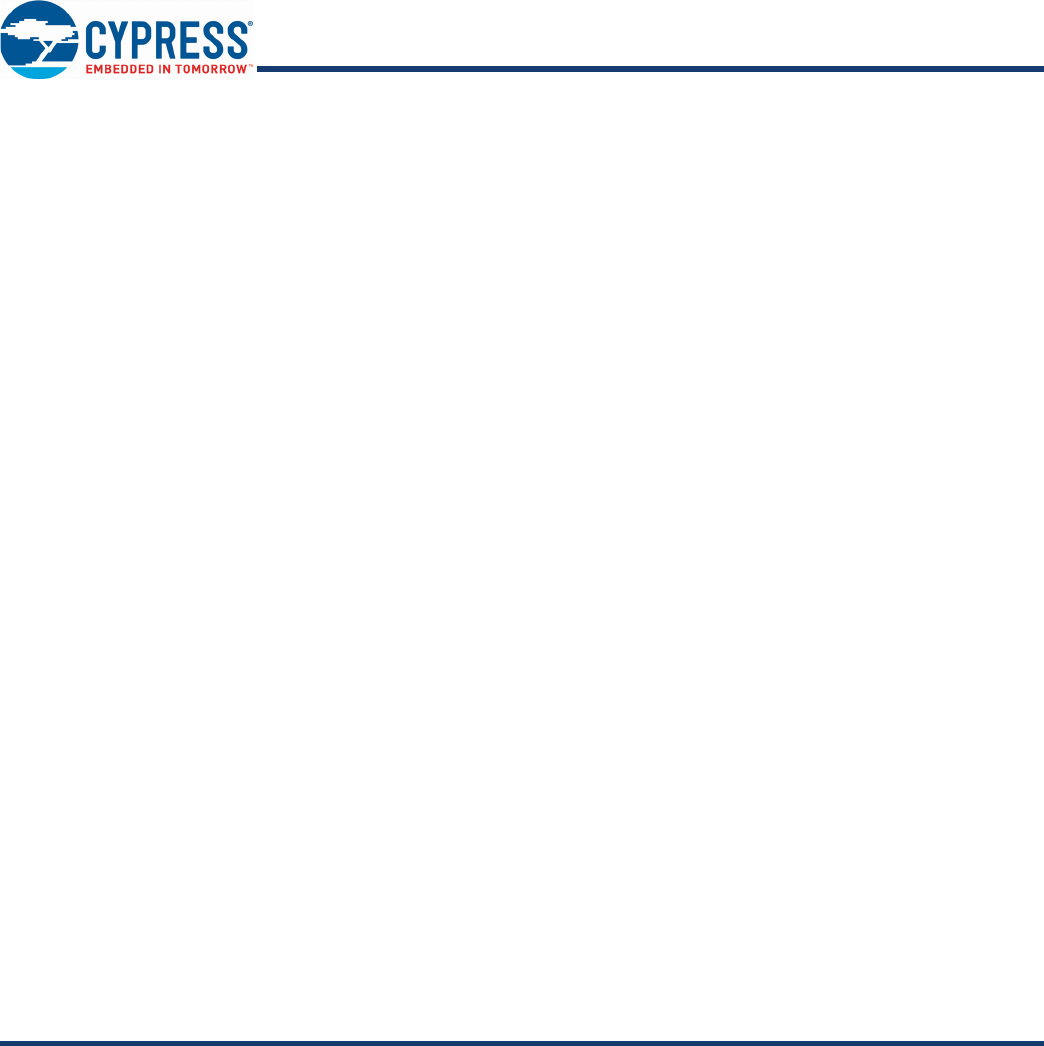
Document Number: 002-23132 Rev. ** Revised March 14, 2018 Page 50 of 50
PRELIMINARY CYBT-353027-02
© Cypress Semiconductor Corporation, 2018. This document is the property of Cypress Semiconductor Corporation and its subsidiaries, including Spansion LLC ("Cypress"). This document, including
any software or firmware included or referenced in this document ("Software"), is owned by Cypress under the intellectual property laws and treaties of the United States and other countries worldwide.
Cypress reserves all rights under such laws and treaties and does not, except as specifically stated in this paragraph, grant any license under its patents, copyrights, trademarks, or other intellectual
property rights. If the Software is not accompanied by a license agreement and you do not otherwise have a written agreement with Cypress governing the use of the Software, then Cypress hereby
grants you a personal, non-exclusive, nontransferable license (without the right to sublicense) (1) under its copyright rights in the Software (a) for Software provided in source code form, to modify and
reproduce the Software solely for use with Cypress hardware products, only internally within your organization, and (b) to distribute the Software in binary code form externally to end users (either
directly or indirectly through resellers and distributors), solely for use on Cypress hardware product units, and (2) under those claims of Cypress's patents that are infringed by the Software (as provided
by Cypress, unmodified) to make, use, distribute, and import the Software solely for use with Cypress hardware products. Any other use, reproduction, modification, translation, or compilation of the
Software is prohibited.
TO THE EXTENT PERMITTED BY APPLICABLE LAW, CYPRESS MAKES NO WARRANTY OF ANY KIND, EXPRESS OR IMPLIED, WITH REGARD TO THIS DOCUMENT OR ANY SOFTWARE
OR ACCOMPANYING HARDWARE, INCLUDING, BUT NOT LIMITED TO, THE IMPLIED WARRANTIES OF MERCHANTABILITY AND FITNESS FOR A PARTICULAR PURPOSE. To the extent
permitted by applicable law, Cypress reserves the right to make changes to this document without further notice. Cypress does not assume any liability arising out of the application or use of any
product or circuit described in this document. Any information provided in this document, including any sample design information or programming code, is provided only for reference purposes. It is
the responsibility of the user of this document to properly design, program, and test the functionality and safety of any application made of this information and any resulting product. Cypress products
are not designed, intended, or authorized for use as critical components in systems designed or intended for the operation of weapons, weapons systems, nuclear installations, life-support devices or
systems, other medical devices or systems (including resuscitation equipment and surgical implants), pollution control or hazardous substances management, or other uses where the failure of the
device or system could cause personal injury, death, or property damage ("Unintended Uses"). A critical component is any component of a device or system whose failure to perform can be reasonably
expected to cause the failure of the device or system, or to affect its safety or effectiveness. Cypress is not liable, in whole or in part, and you shall and hereby do release Cypress from any claim,
damage, or other liability arising from or related to all Unintended Uses of Cypress products. You shall indemnify and hold Cypress harmless from and against all claims, costs, damages, and other
liabilities, including claims for personal injury or death, arising from or related to any Unintended Uses of Cypress products.
Cypress, the Cypress logo, Spansion, the Spansion logo, and combinations thereof, WICED, PSoC, CapSense, EZ-USB, F-RAM, and Traveo are trademarks or registered trademarks of Cypress in
the United States and other countries. For a more complete list of Cypress trademarks, visit cypress.com. Other names and brands may be claimed as property of their respective owners.
Sales, Solutions, and Legal Information
Worldwide Sales and Design Support
Cypress maintains a worldwide network of offices, solution centers, manufacturer’s representatives, and distributors. To find the office
closest to you, visit us at Cypress Locations.
Products
ARM® Cortex® Microcontrollers cypress.com/arm
Automotive cypress.com/automotive
Clocks & Buffers cypress.com/clocks
Interface cypress.com/interface
Internet of Things cypress.com/iot
Memory cypress.com/memory
Microcontrollers cypress.com/mcu
PSoC cypress.com/psoc
Power Management ICs cypress.com/pmic
Touch Sensing cypress.com/touch
USB Controllers cypress.com/usb
Wireless Connectivity cypress.com/wireless
PSoC® Solutions
PSoC 1 | PSoC 3 | PSoC 4 | PSoC 5LP | PSoC 6
Cypress Developer Community
Forums | WICED IOT Forums | Projects | Video | Blogs |
Training | Components
Technical Support
cypress.com/support
